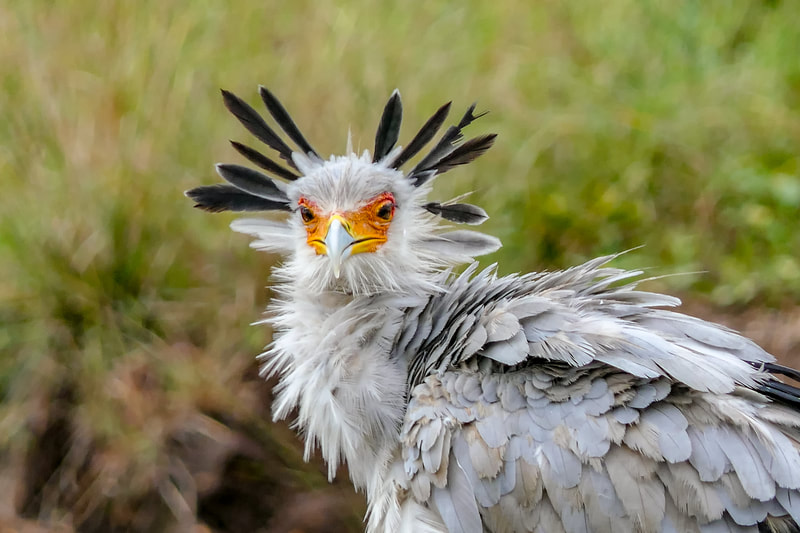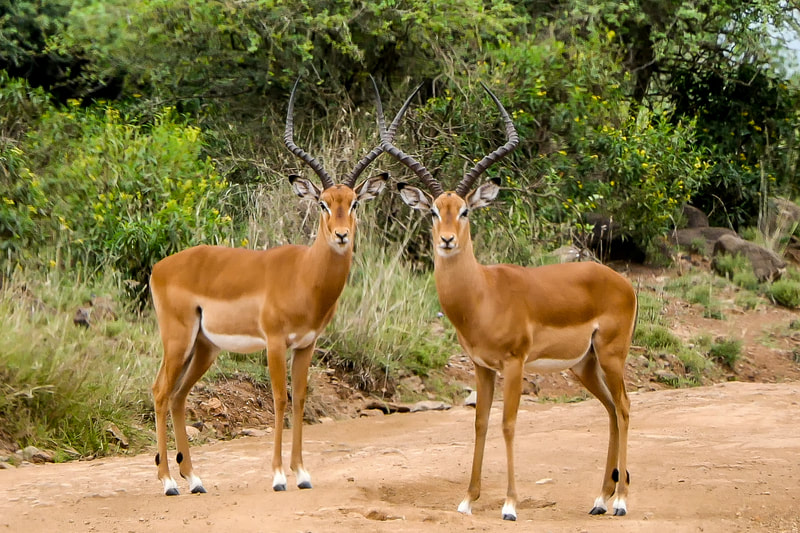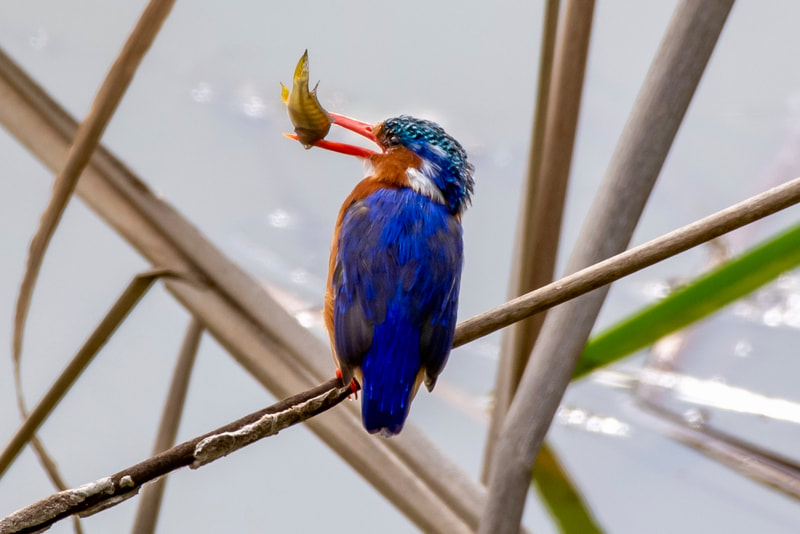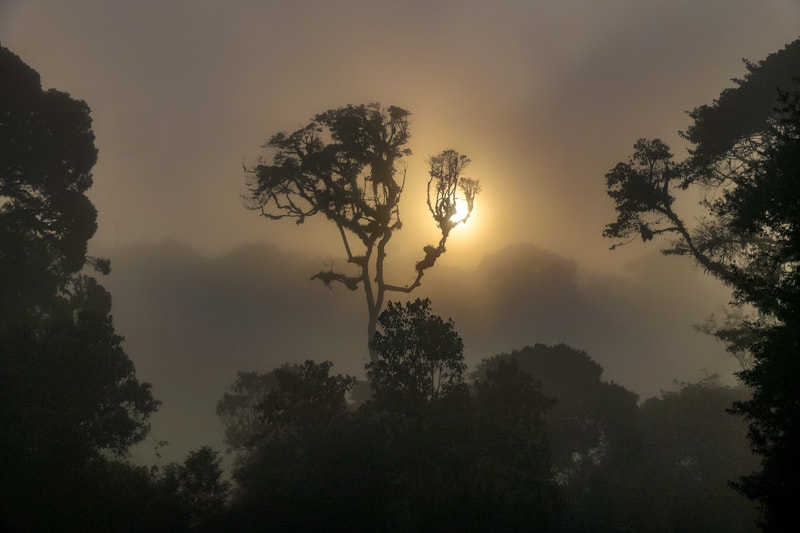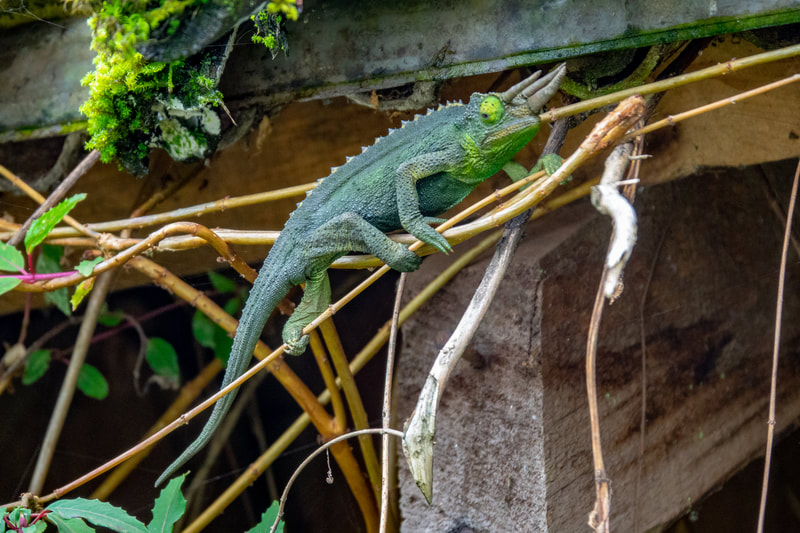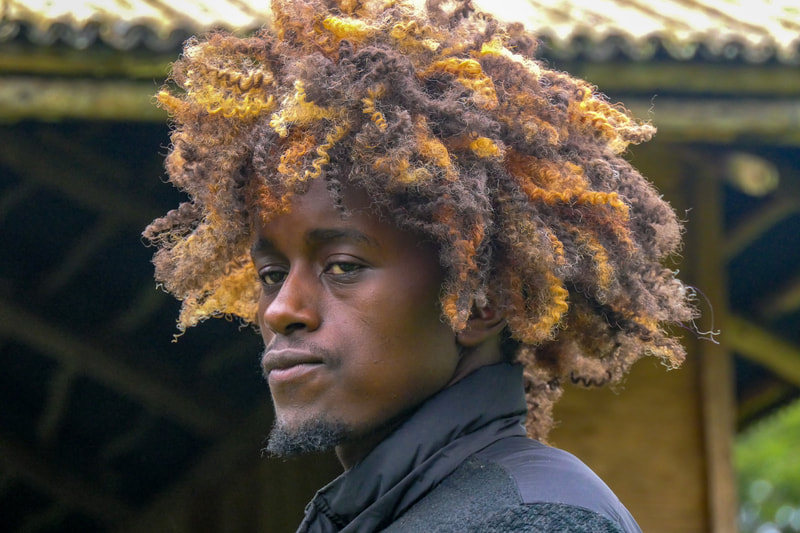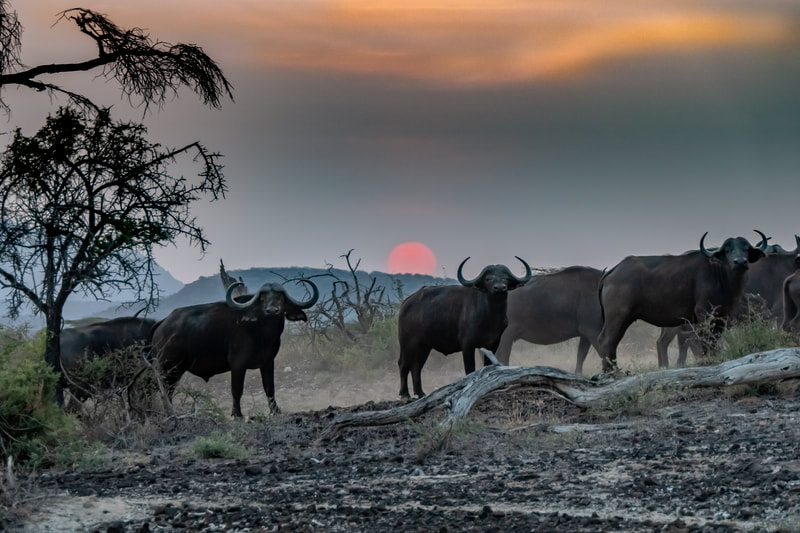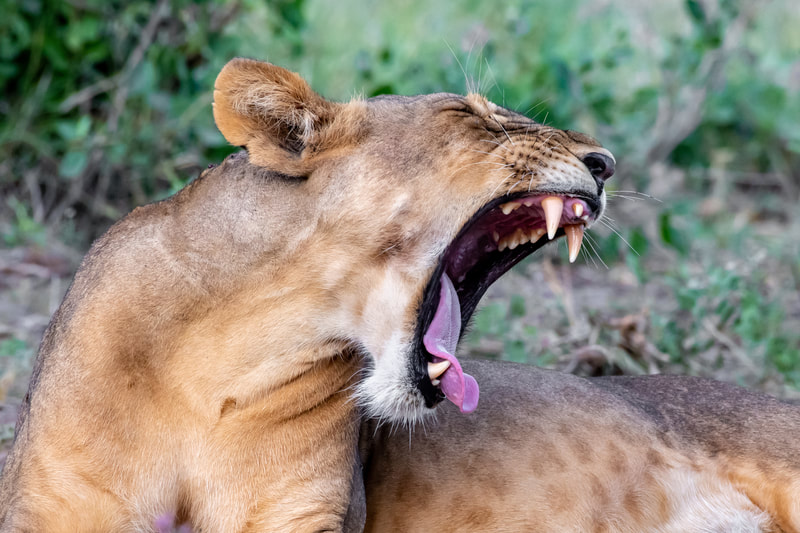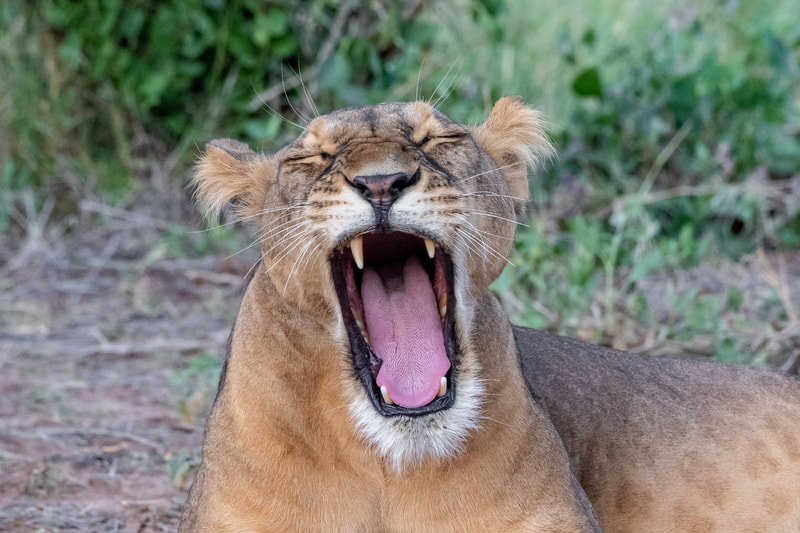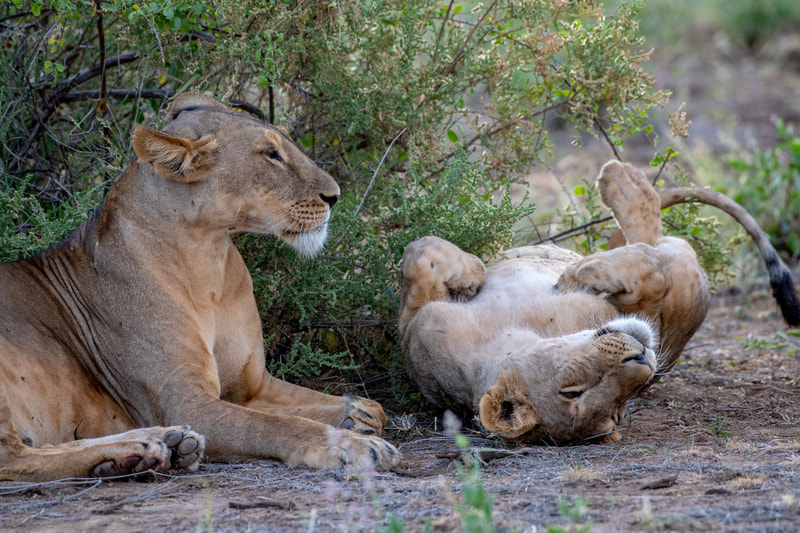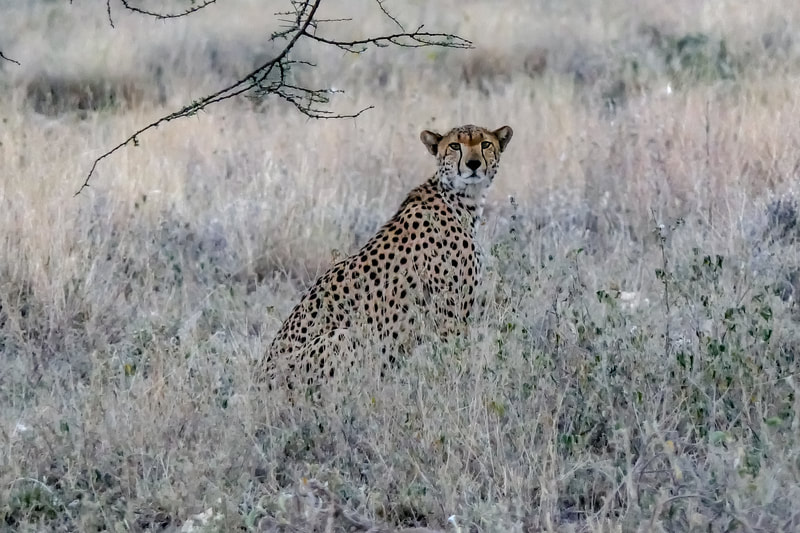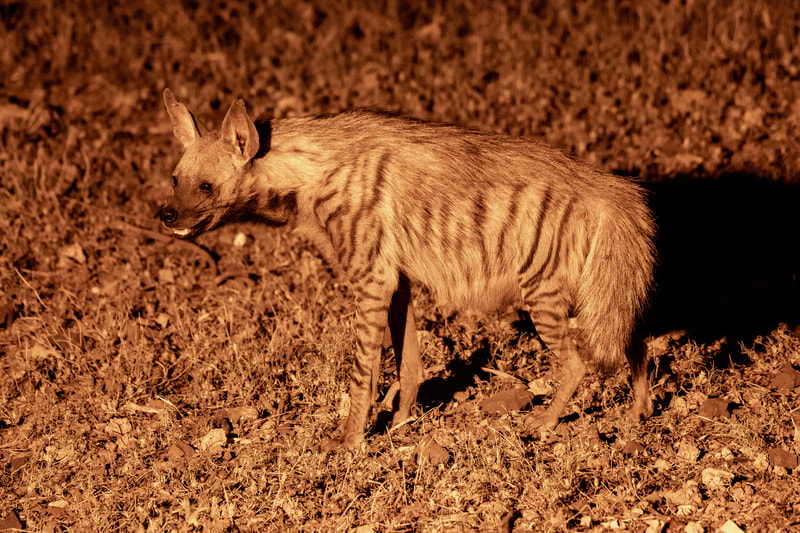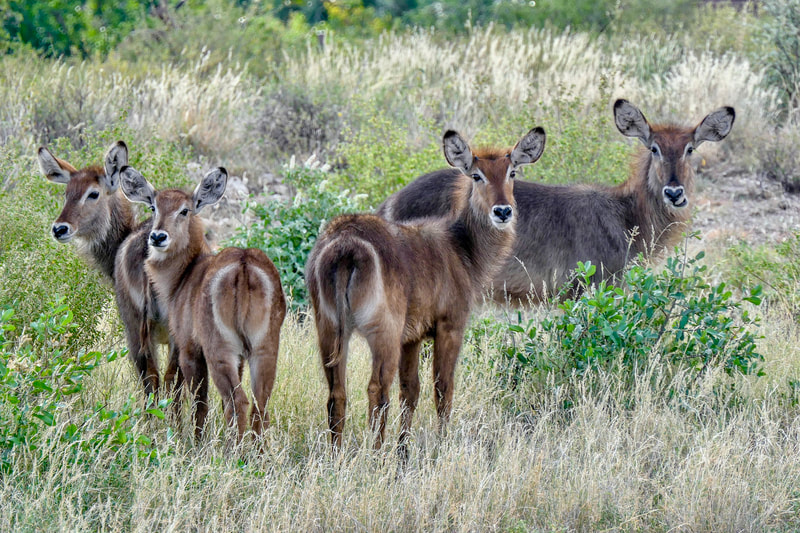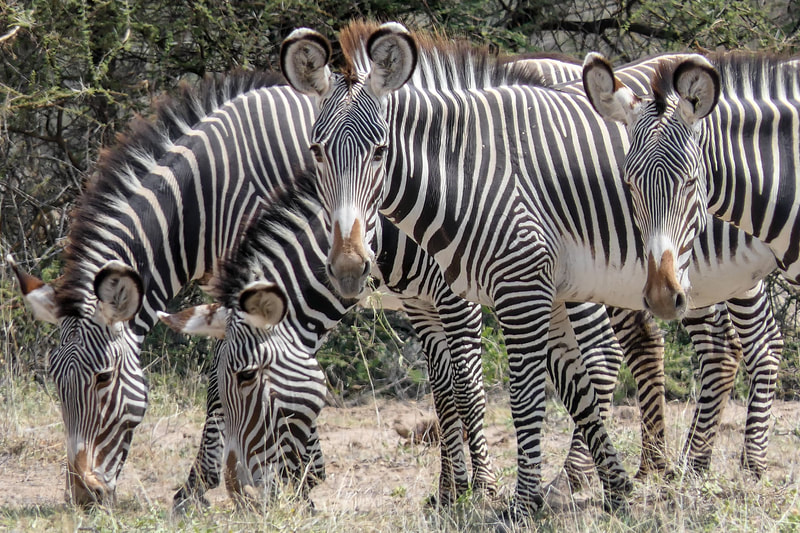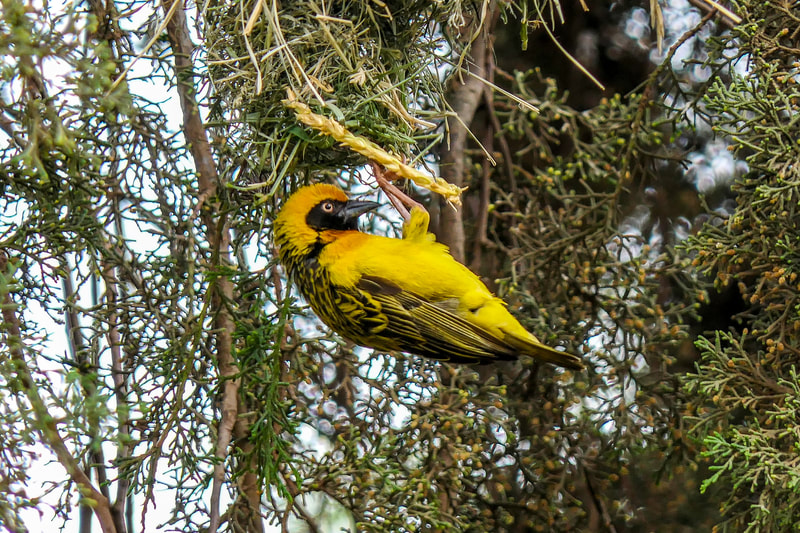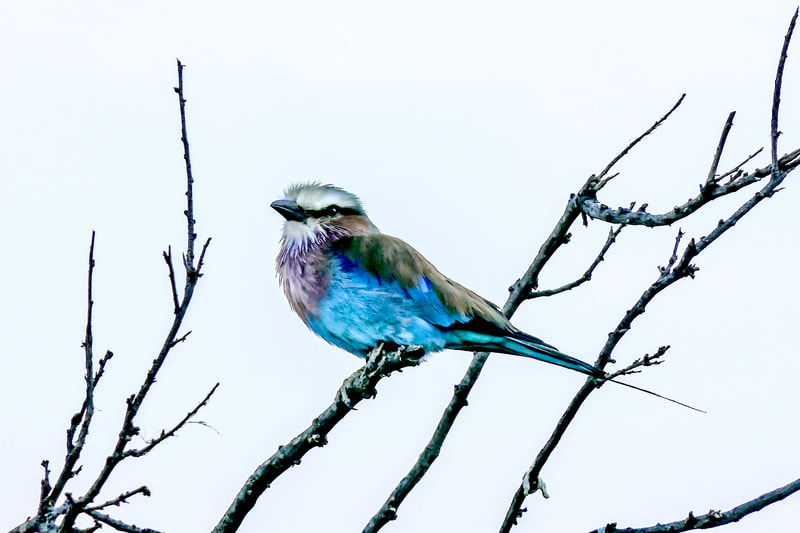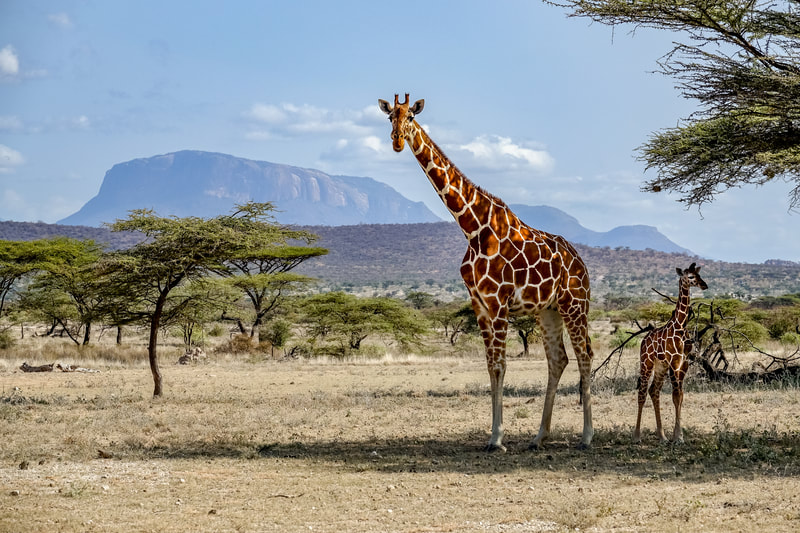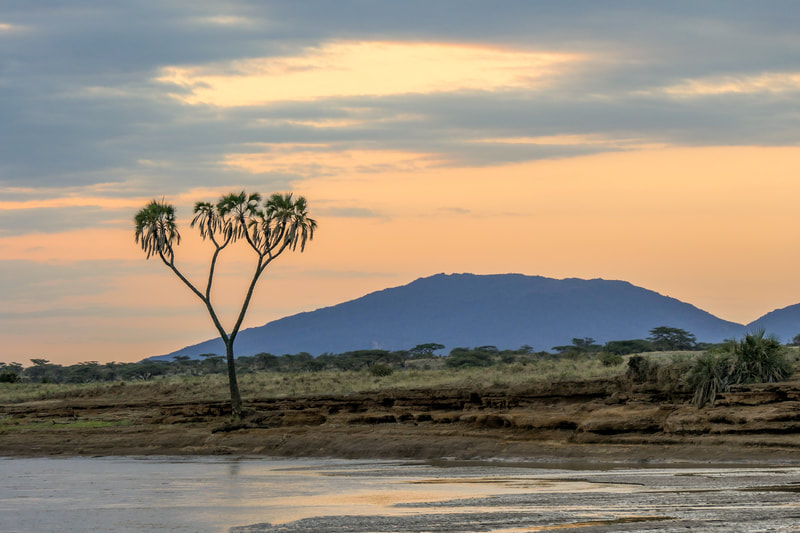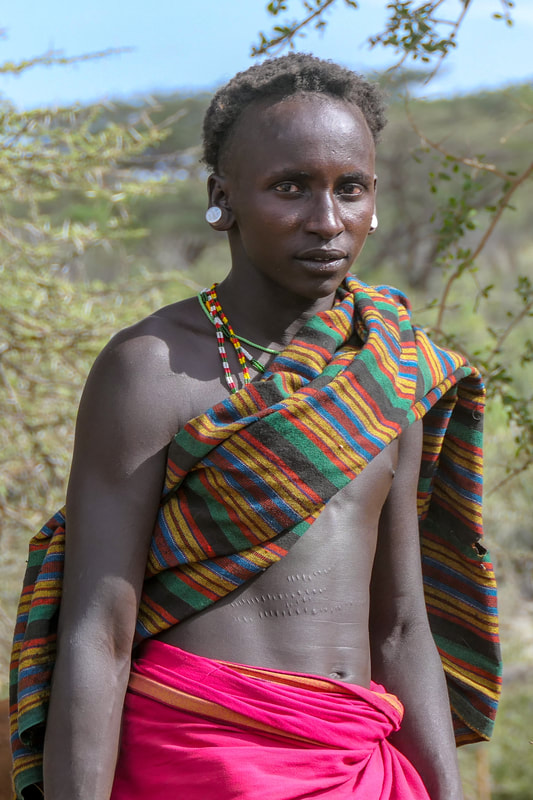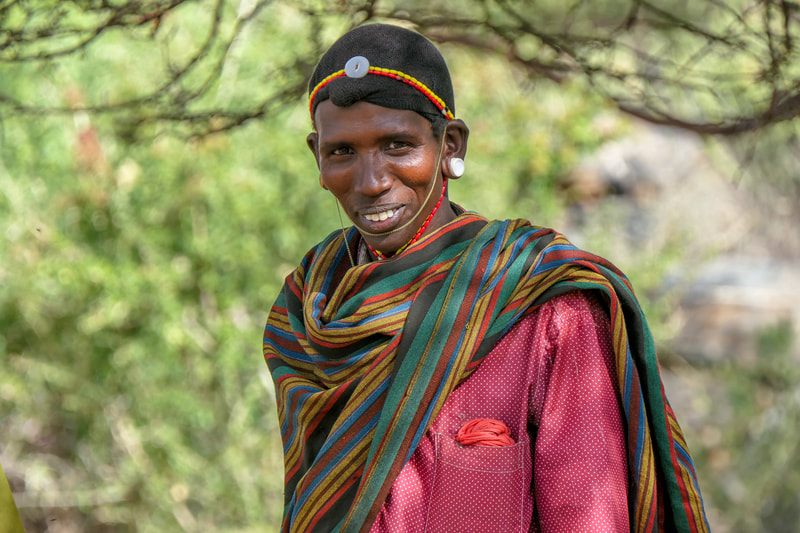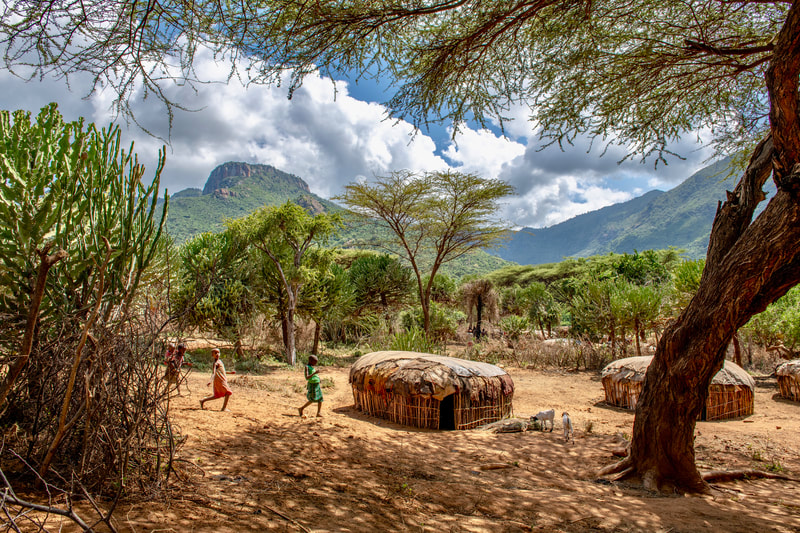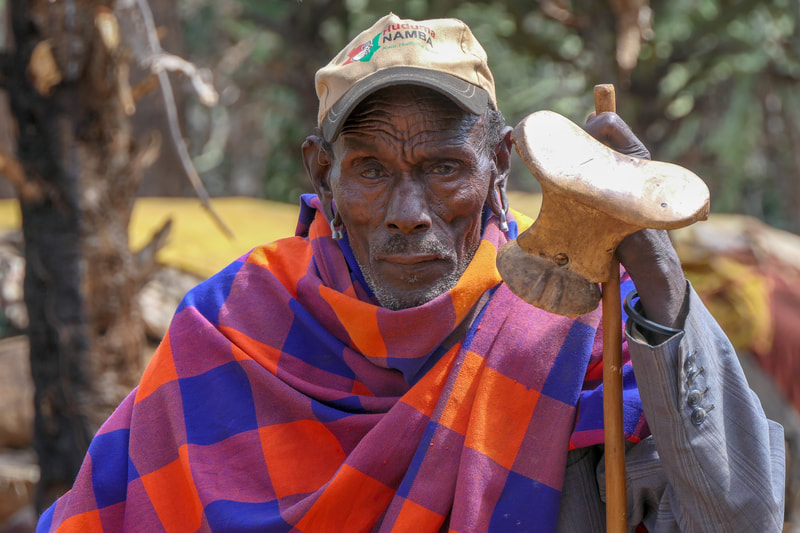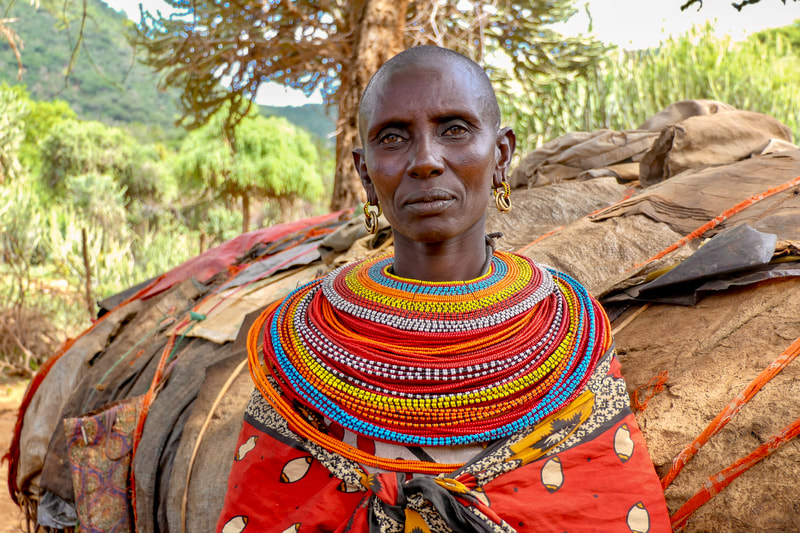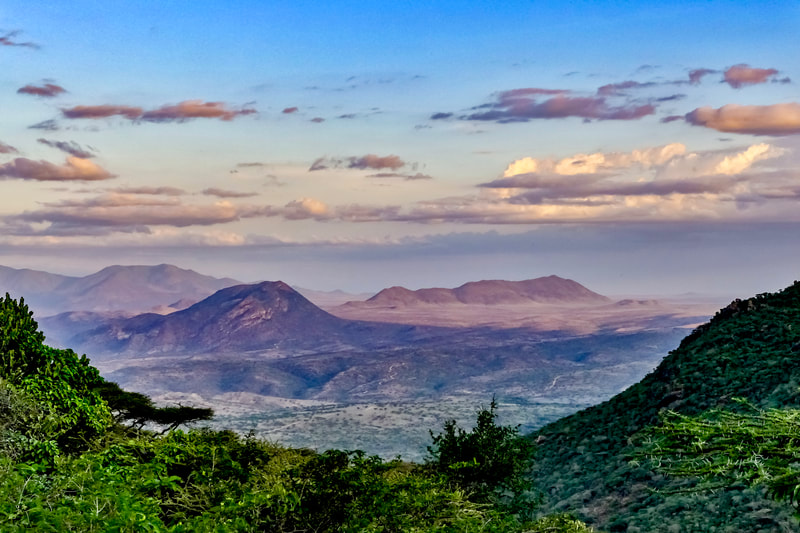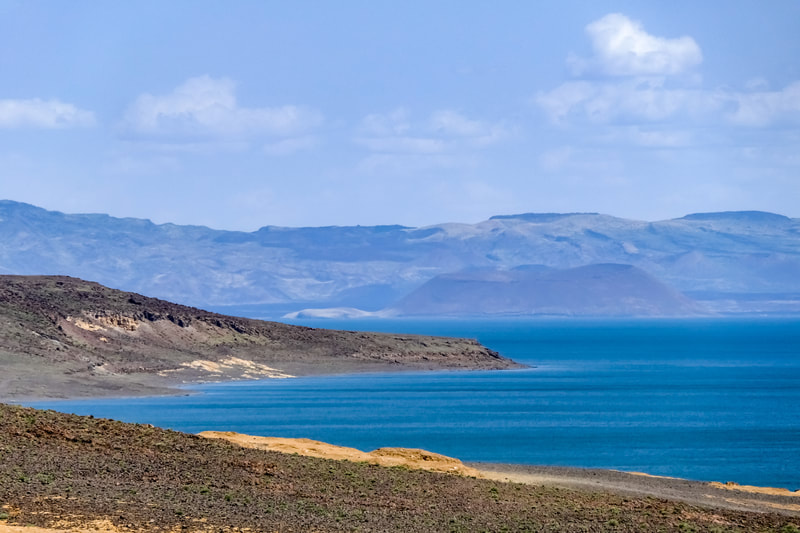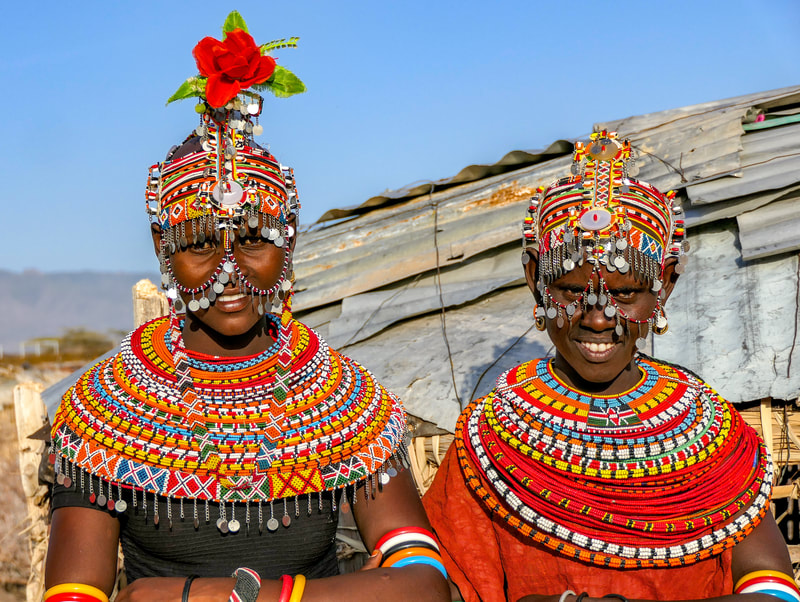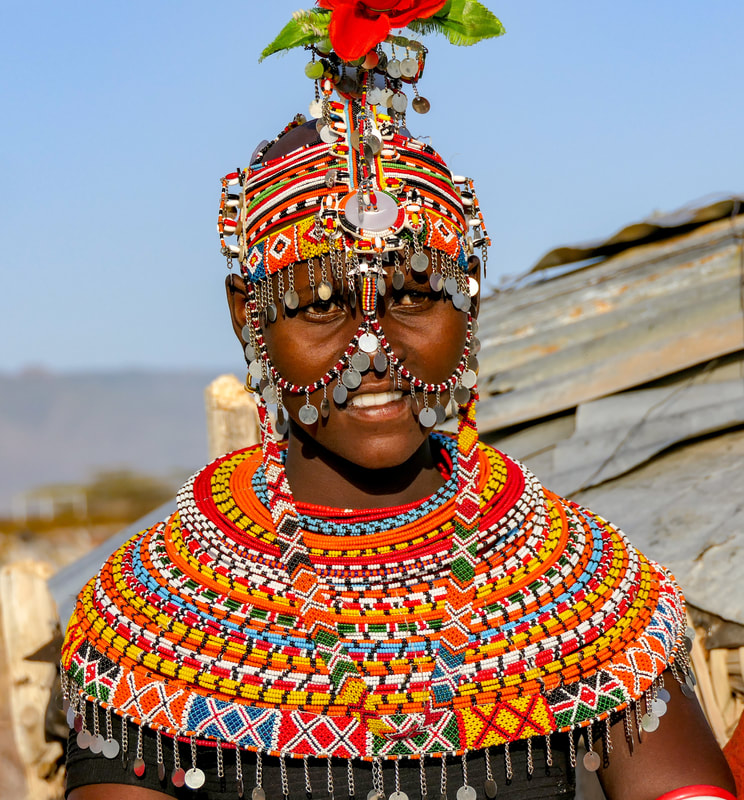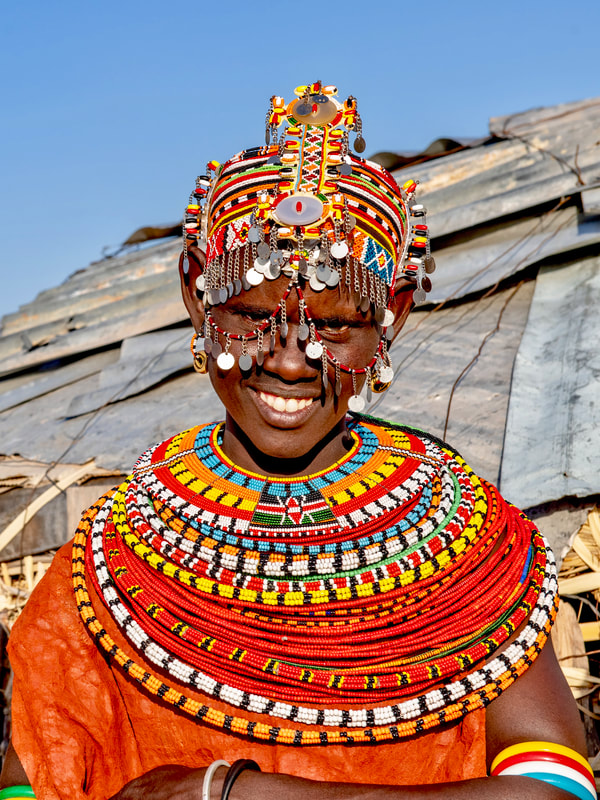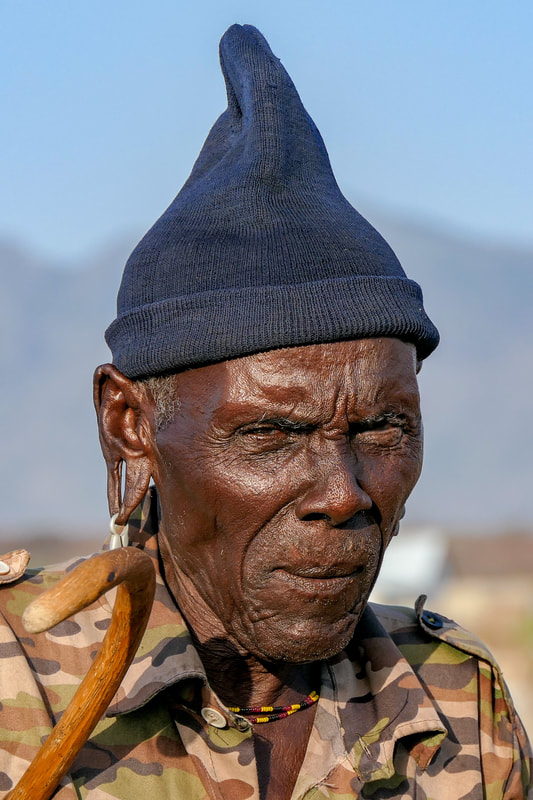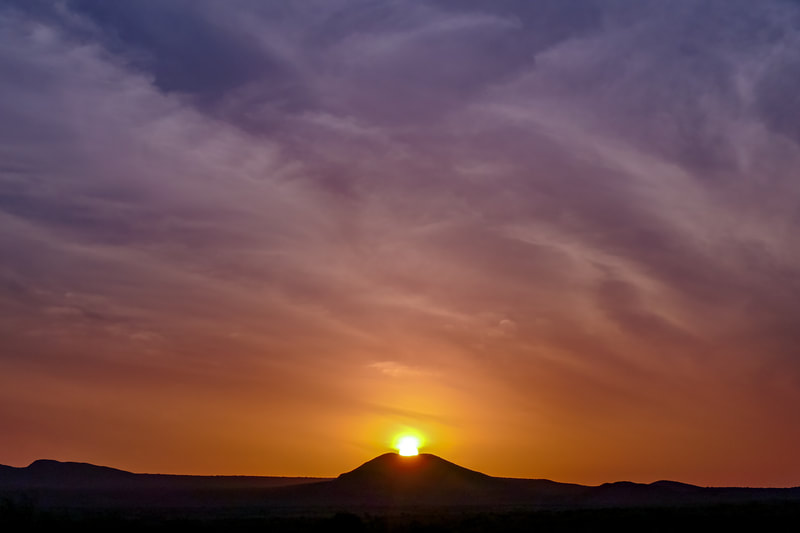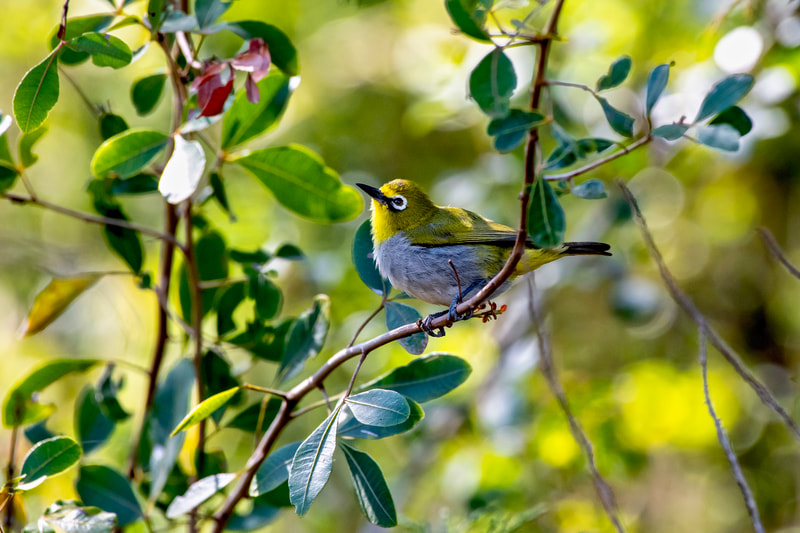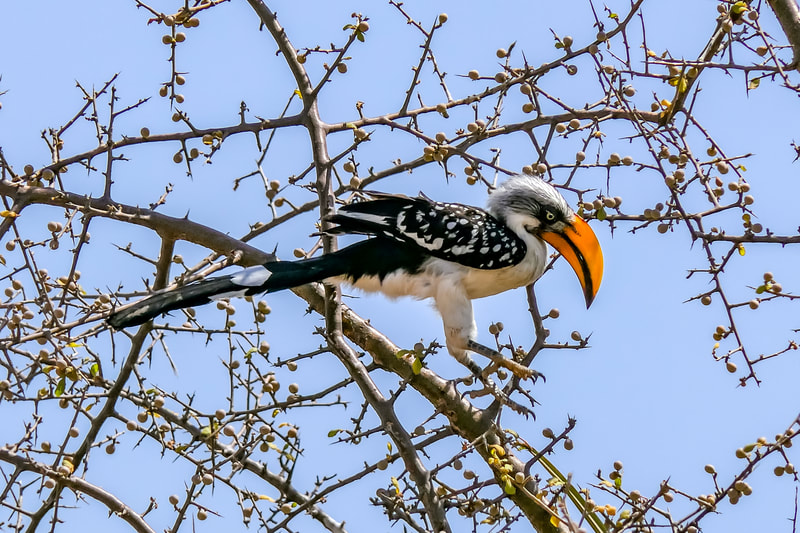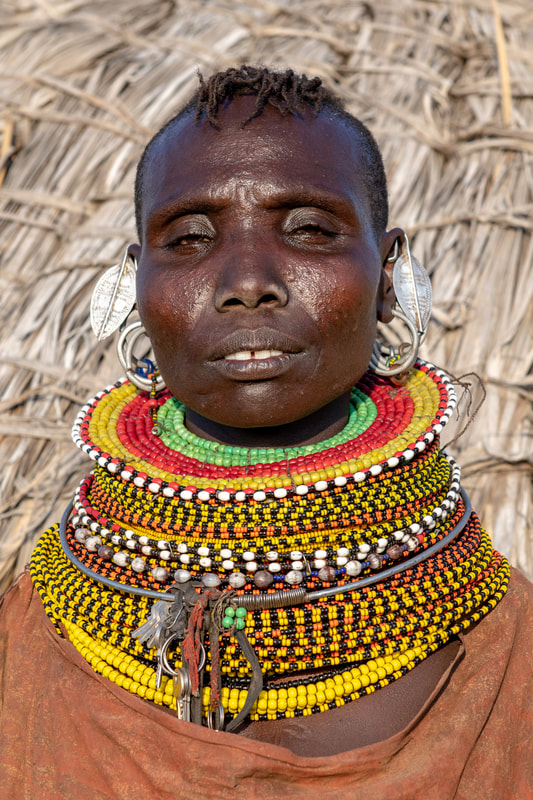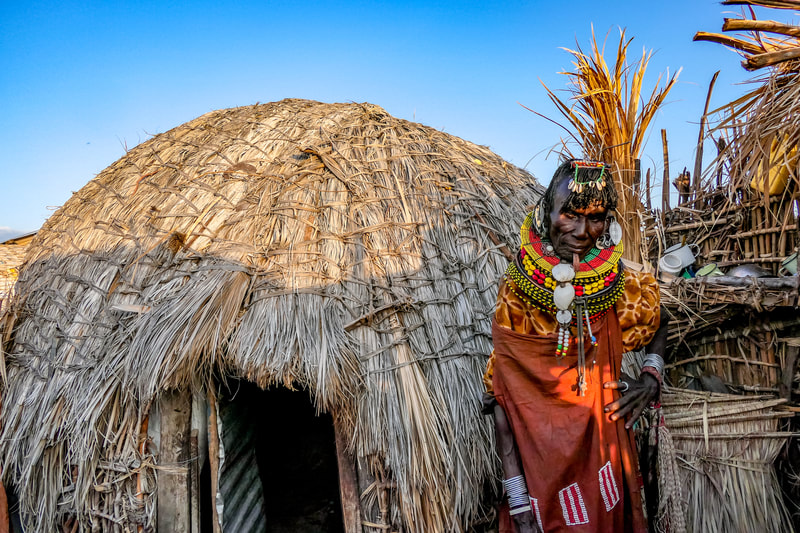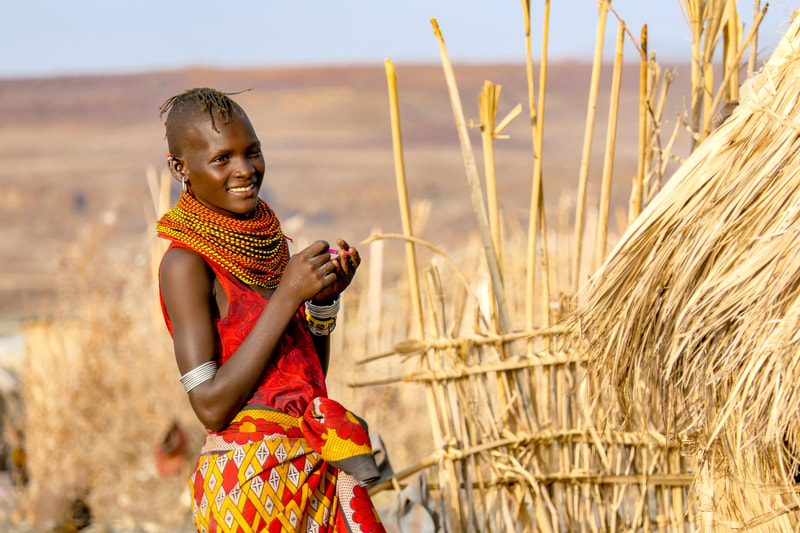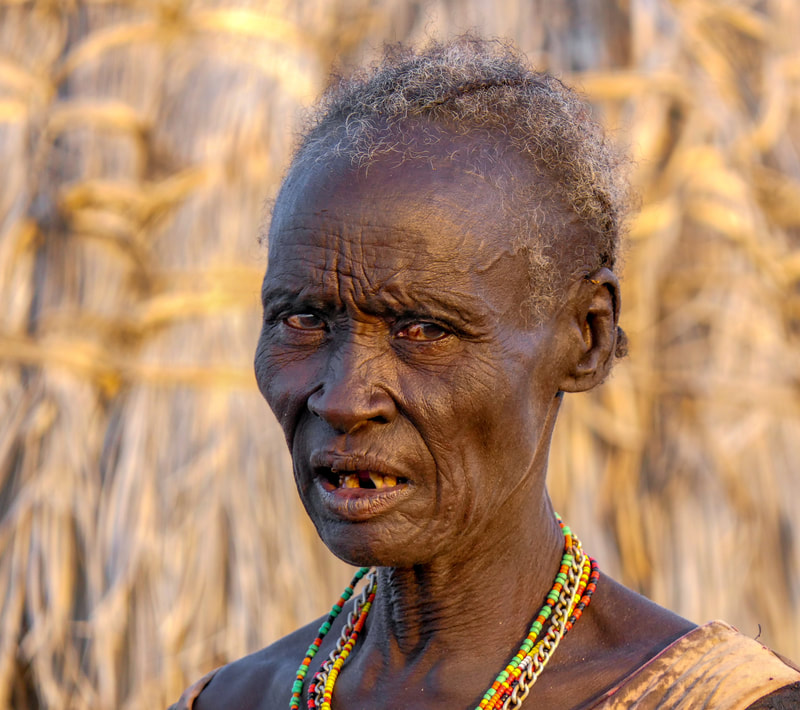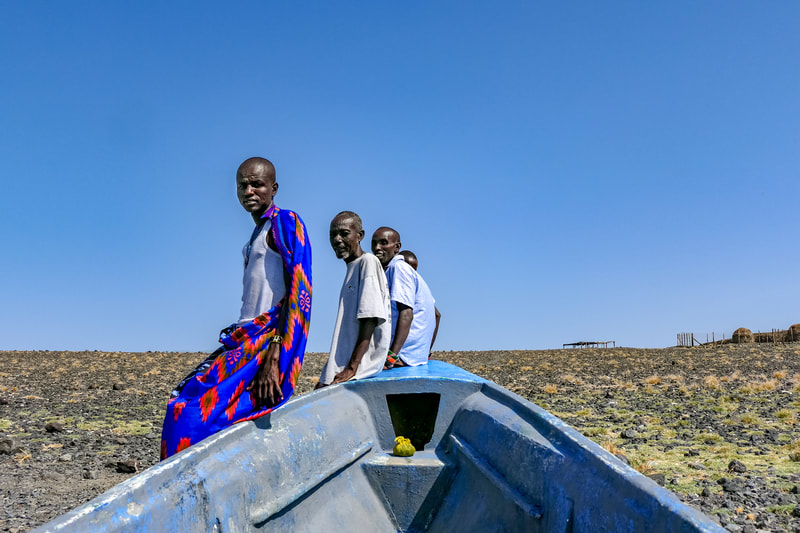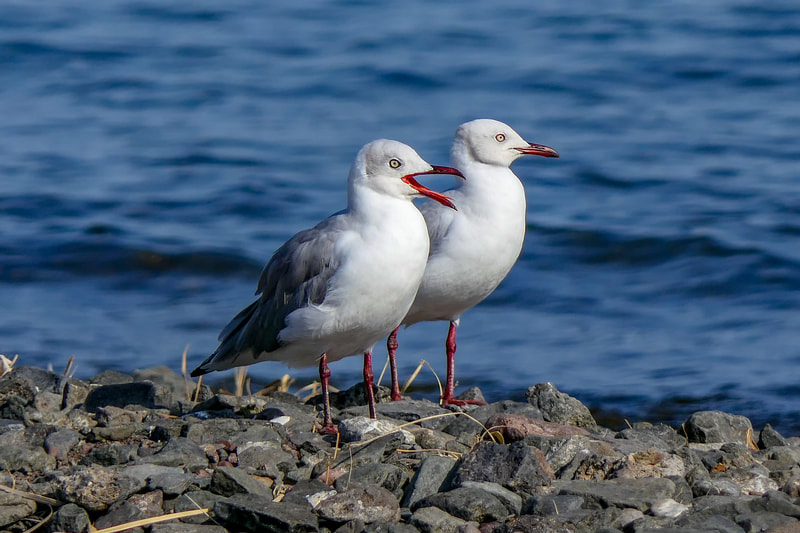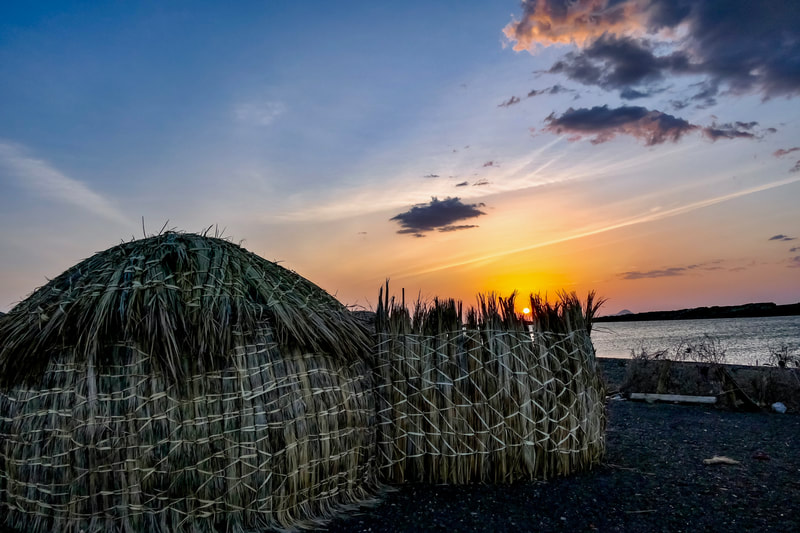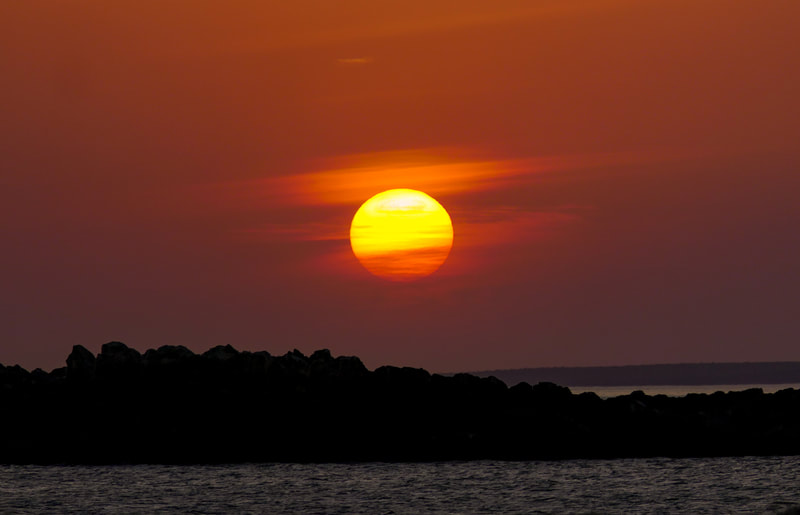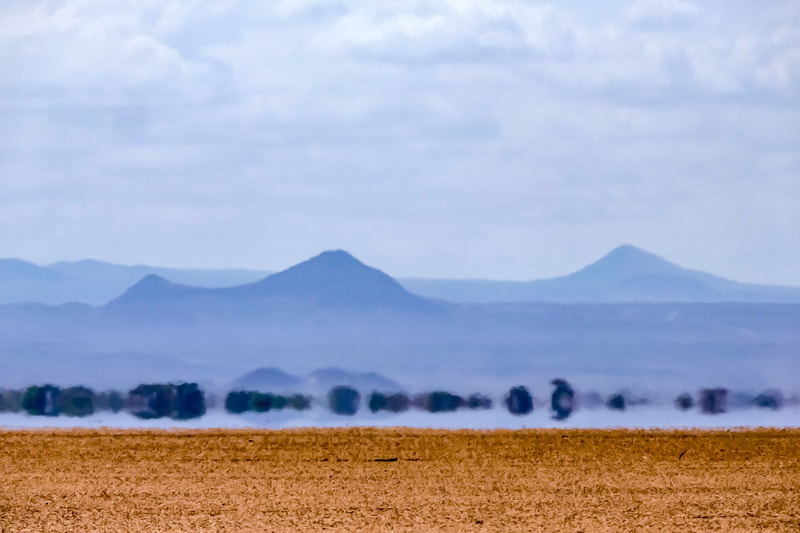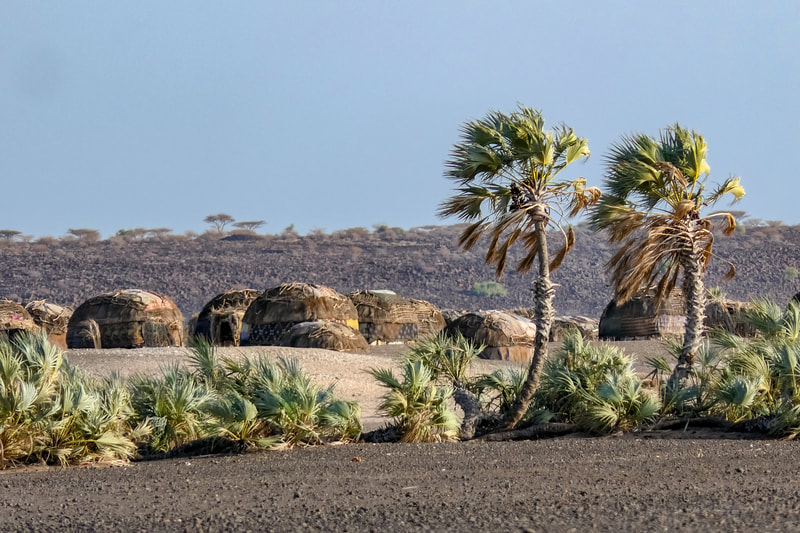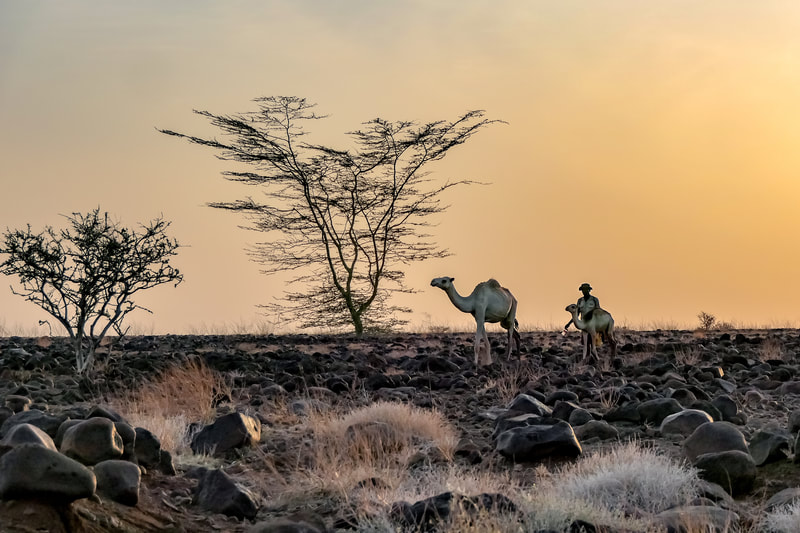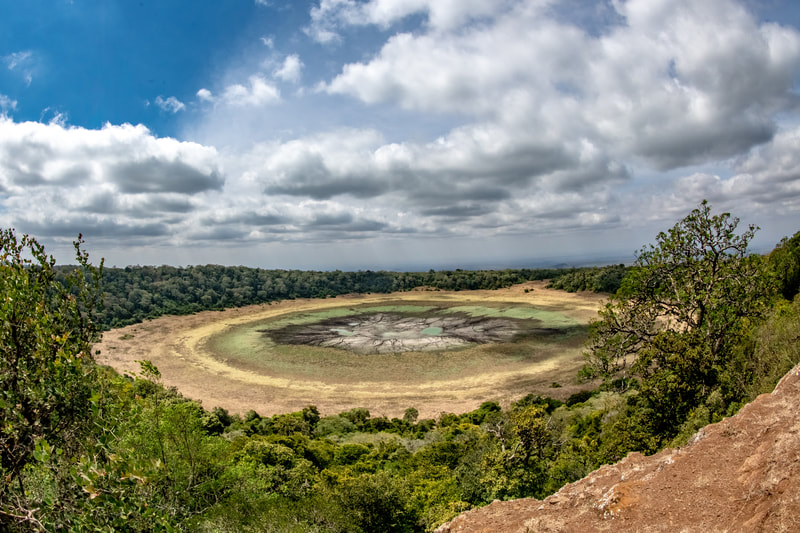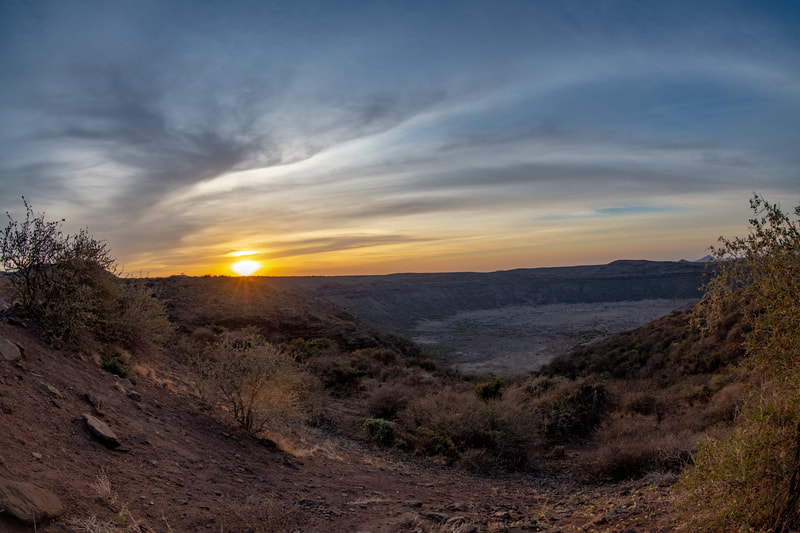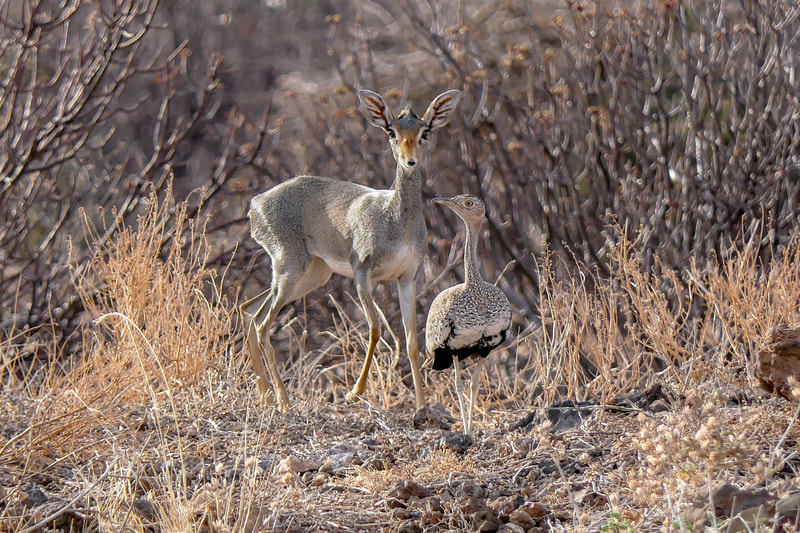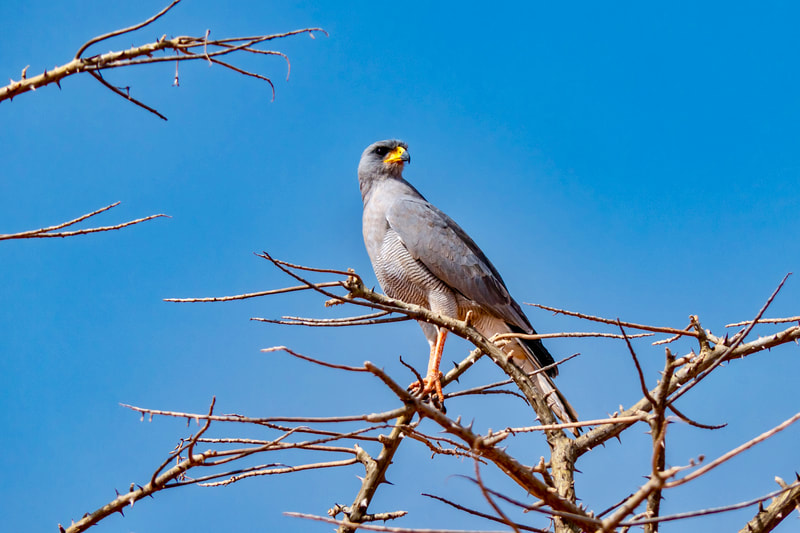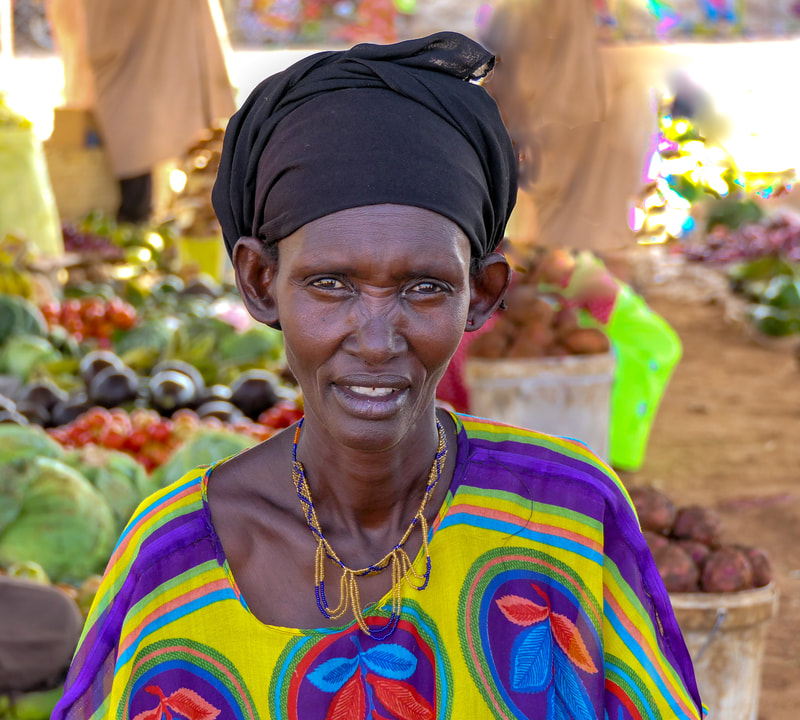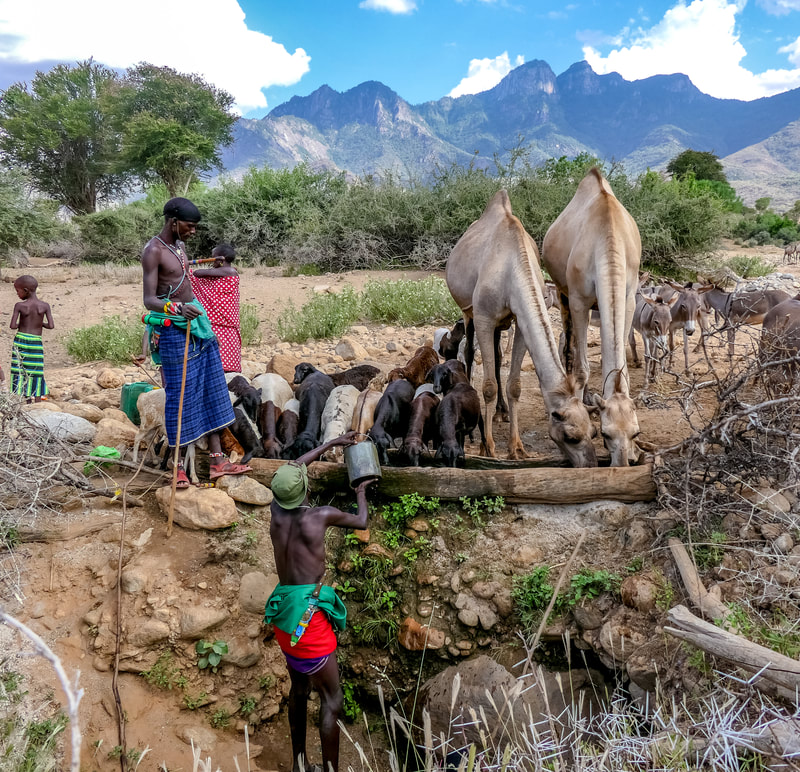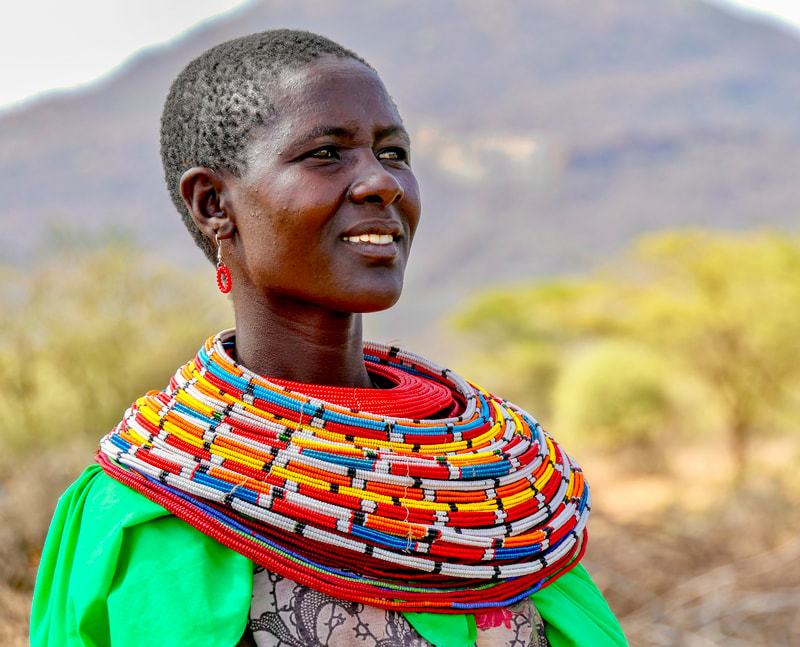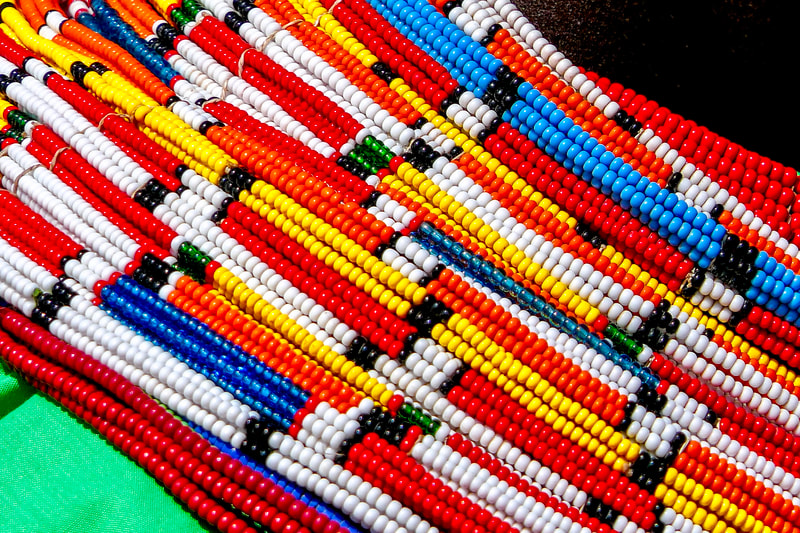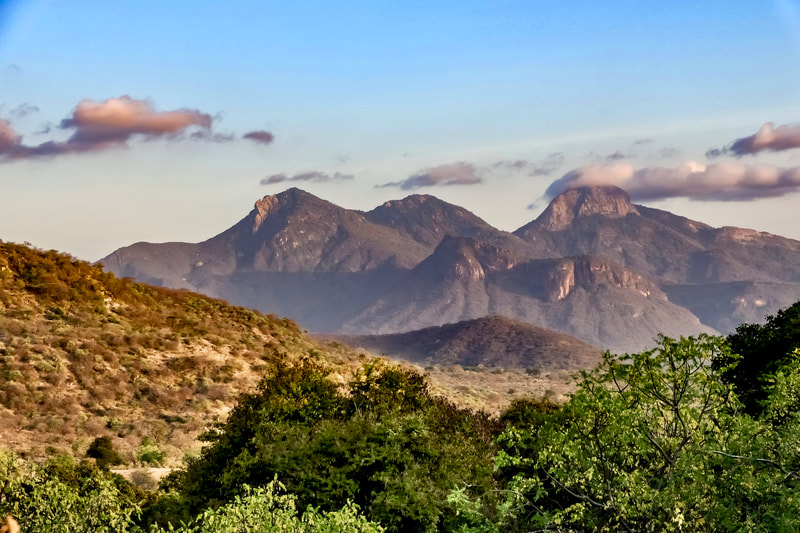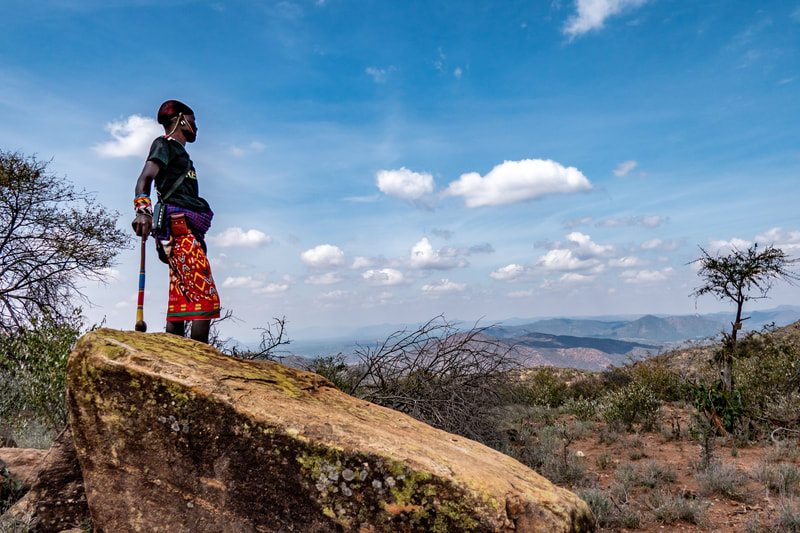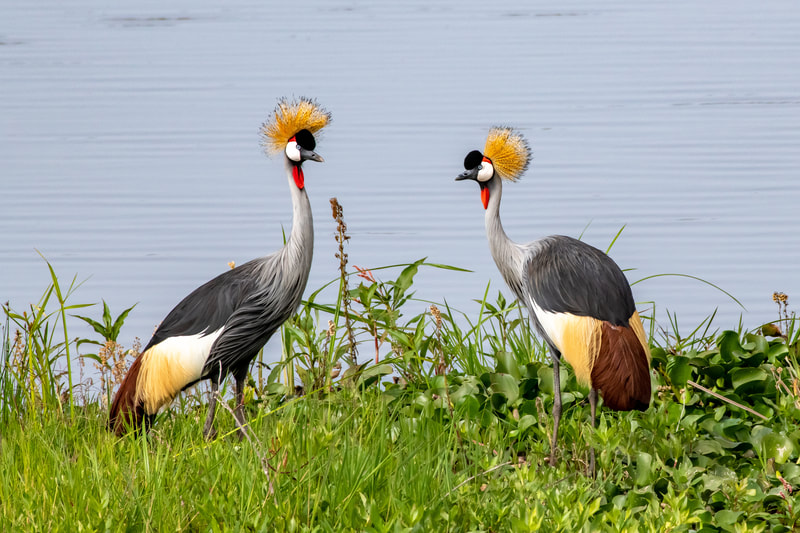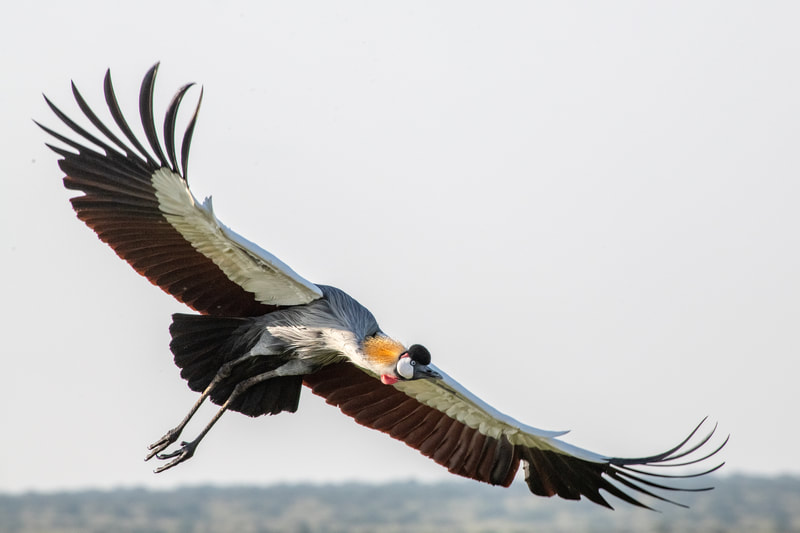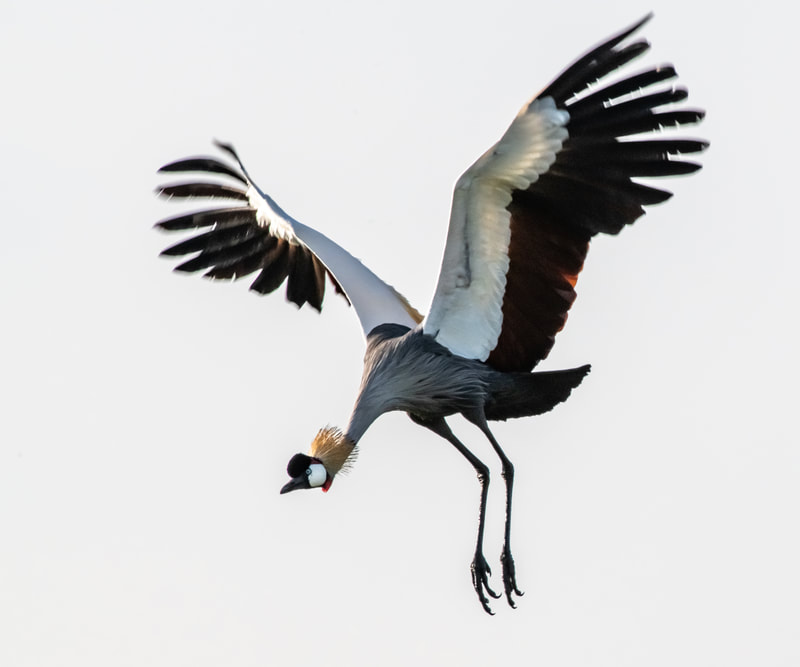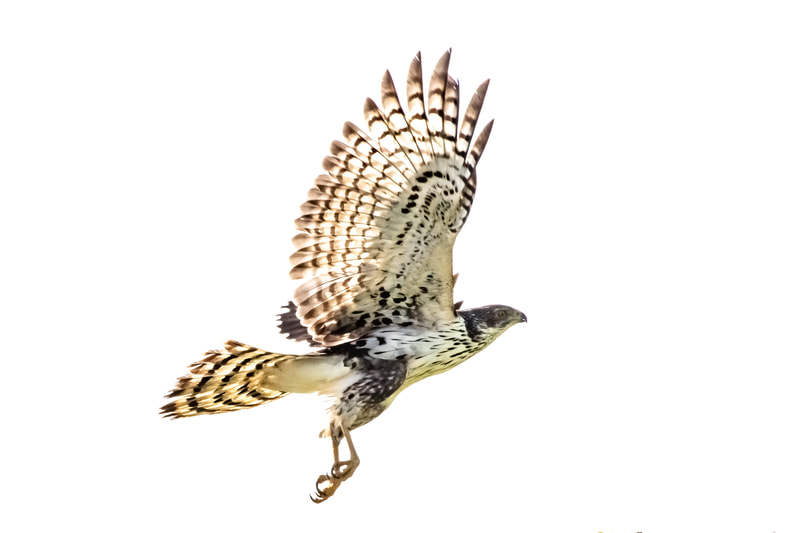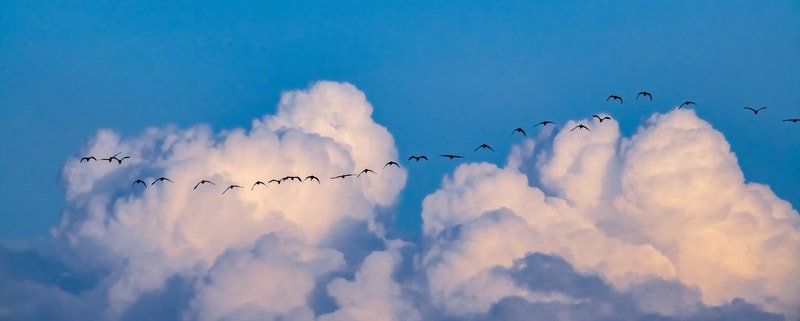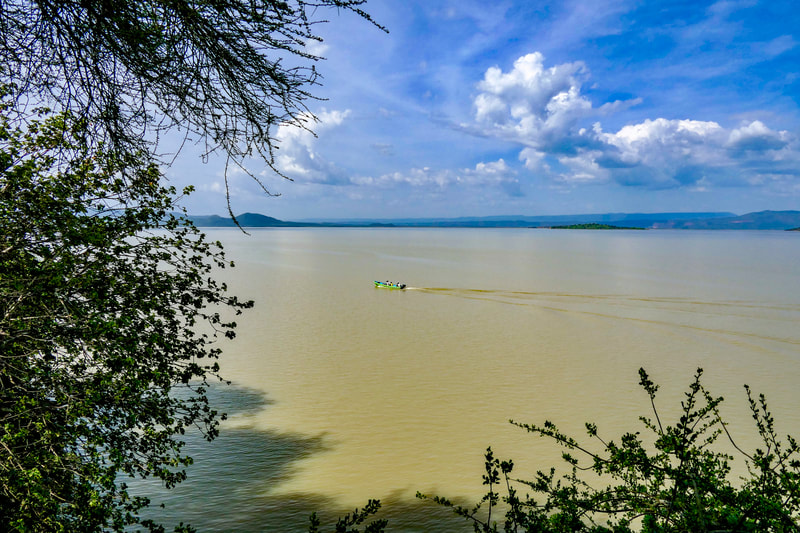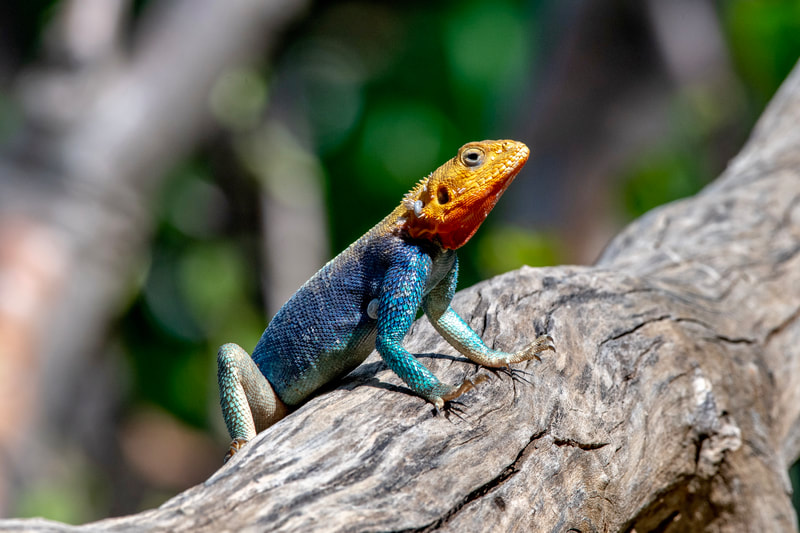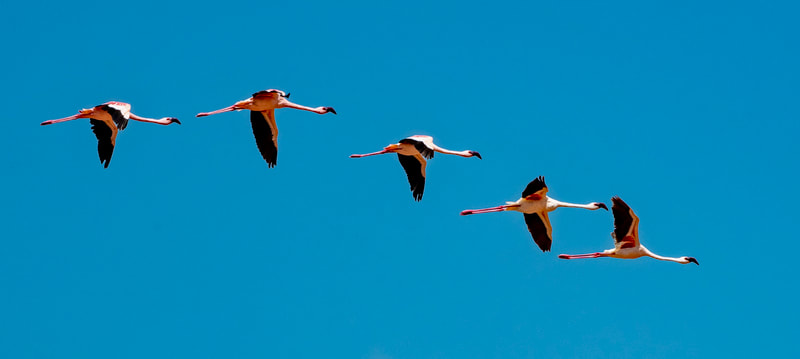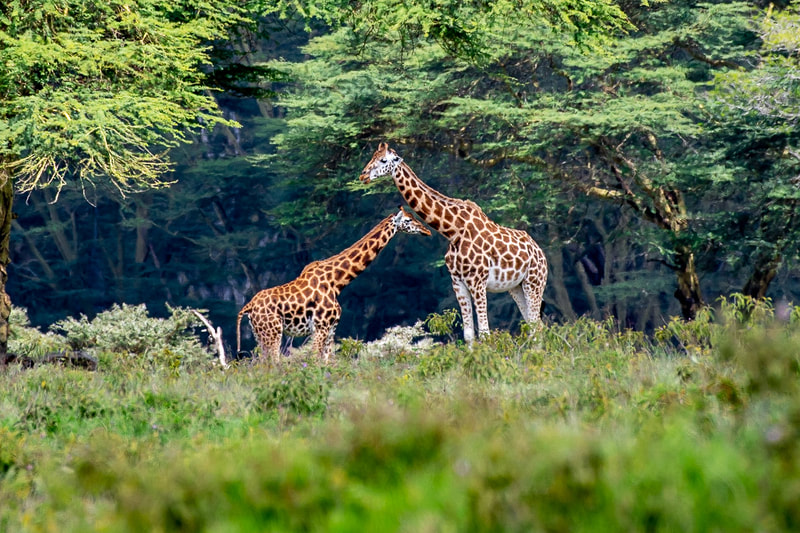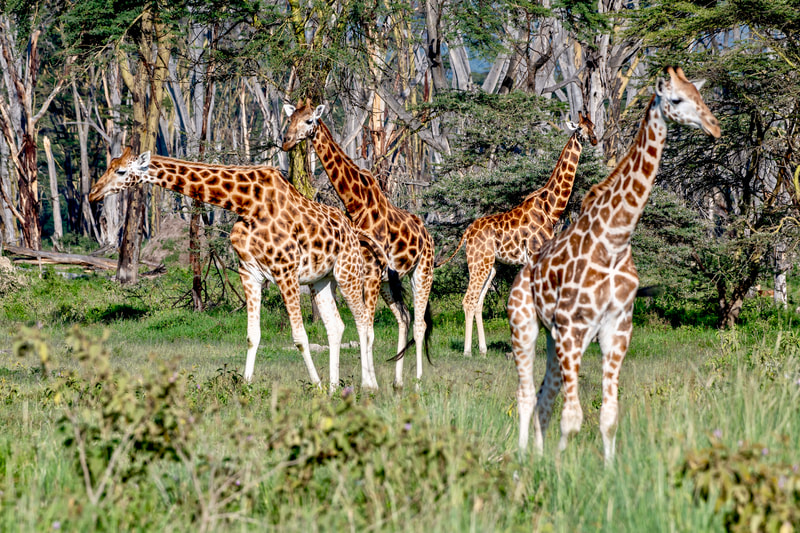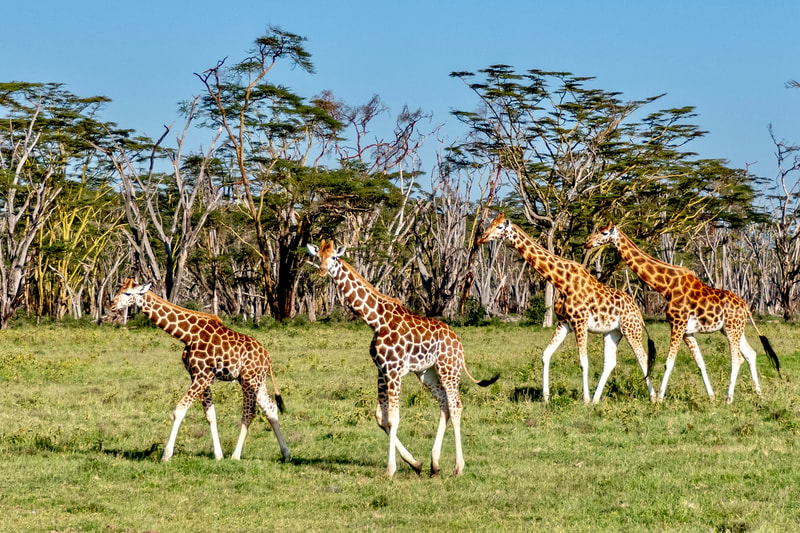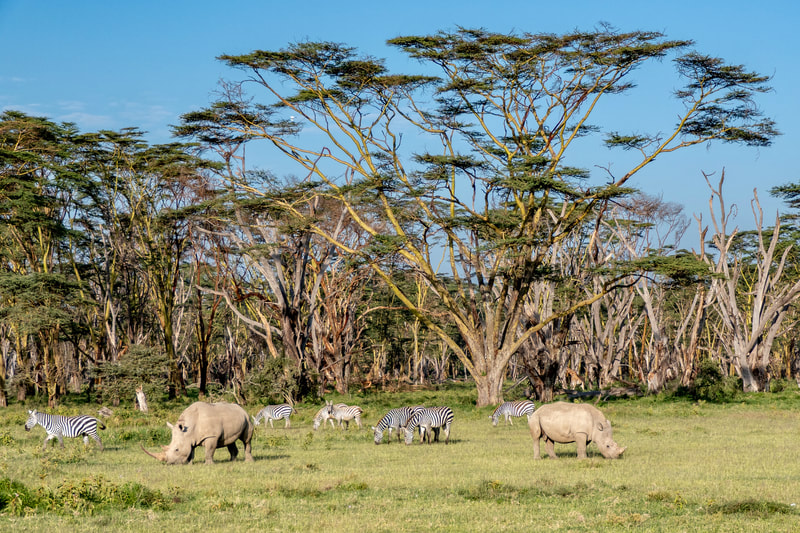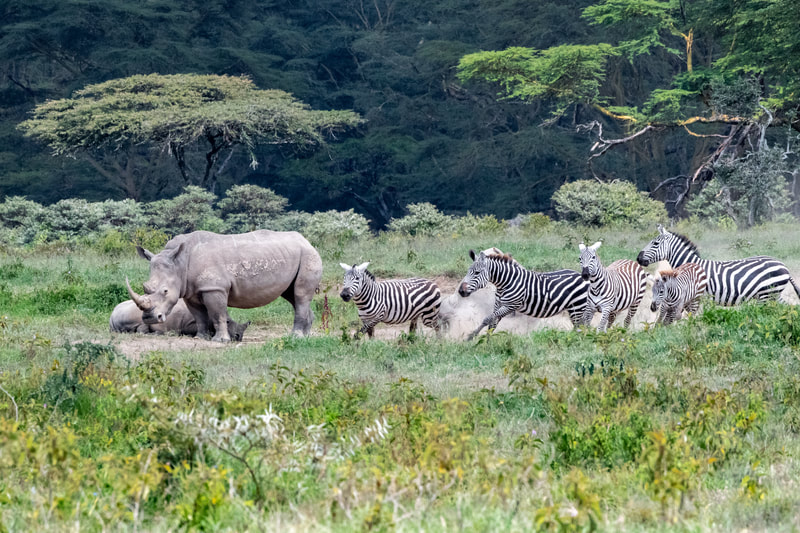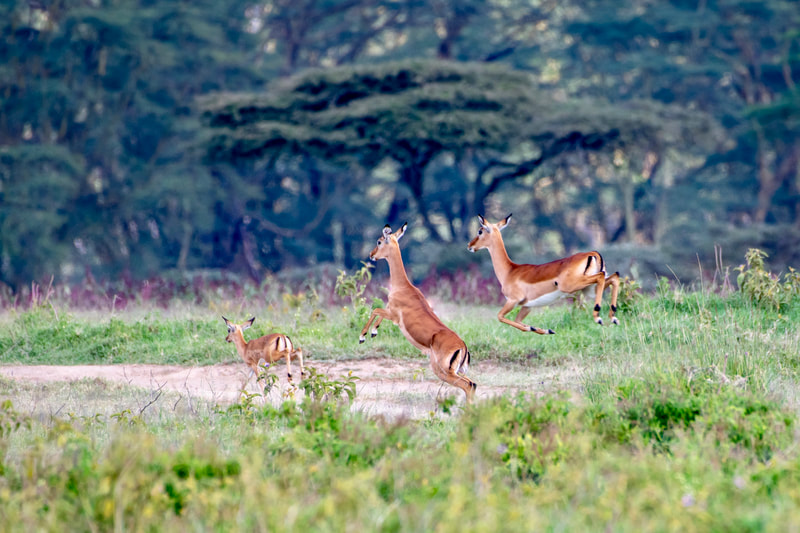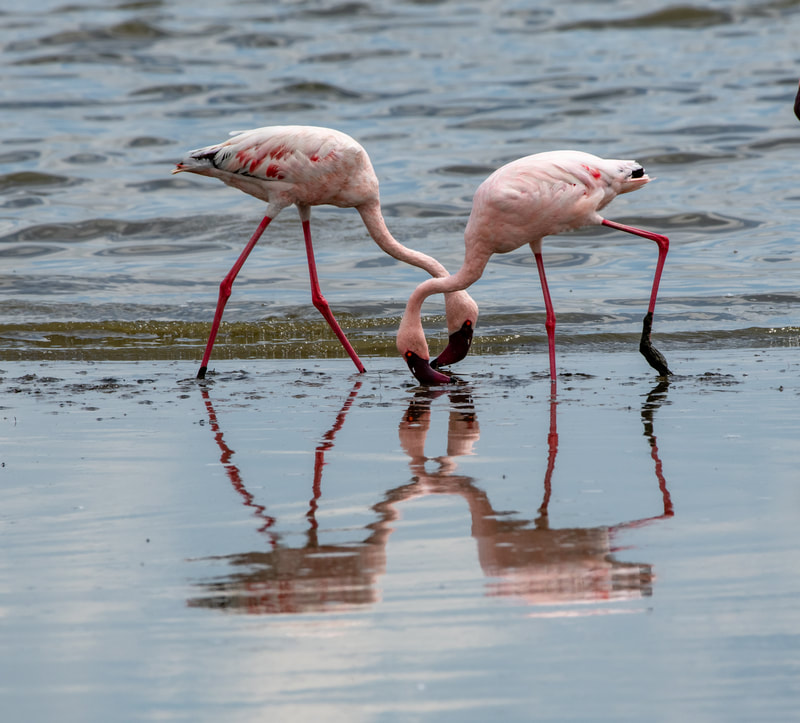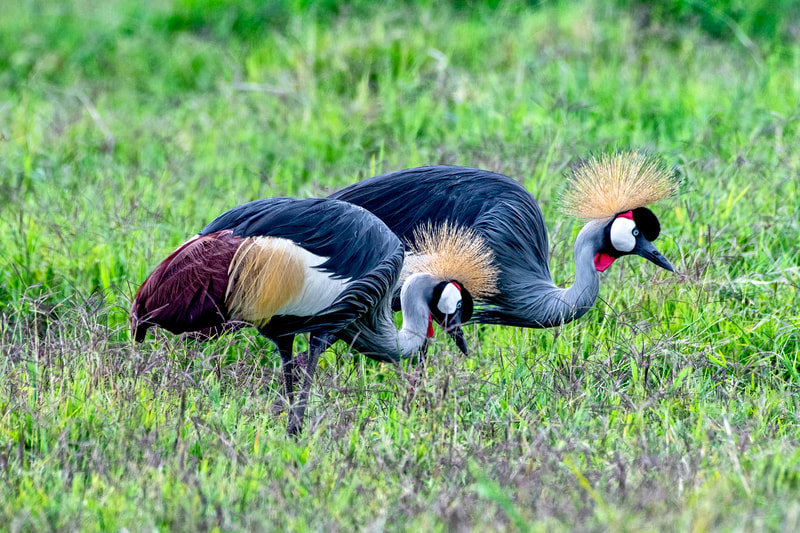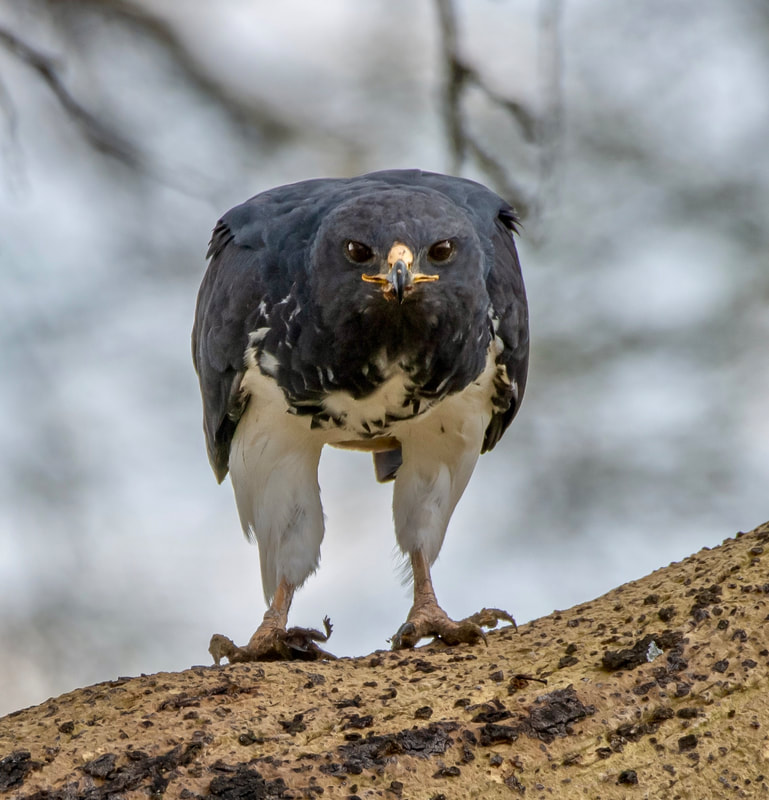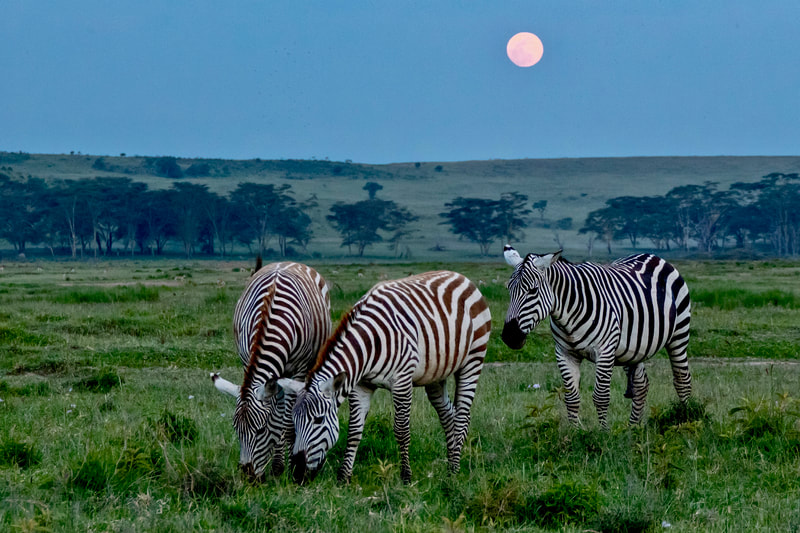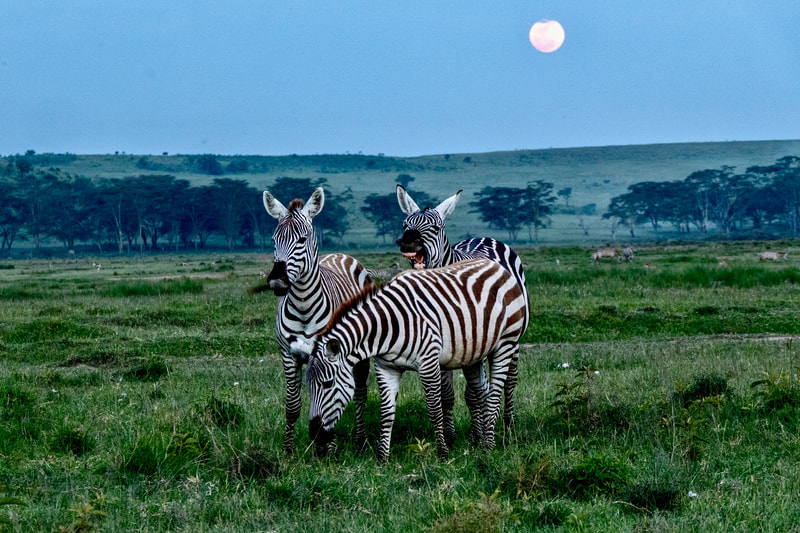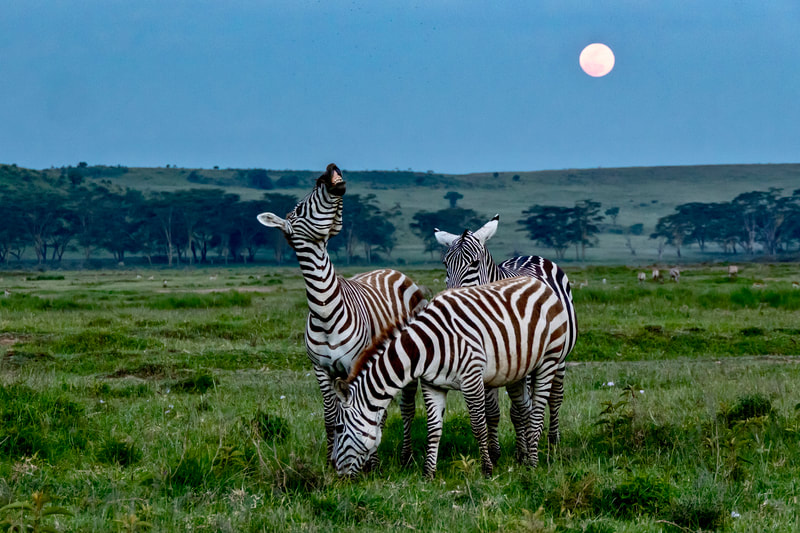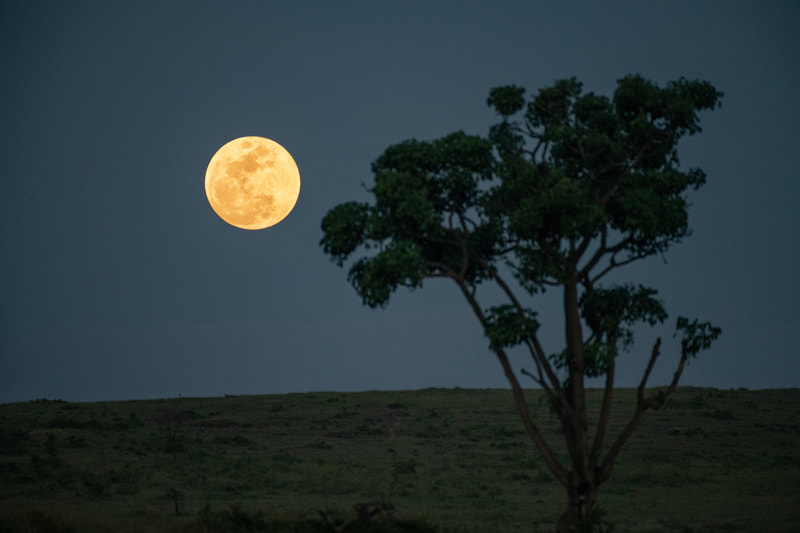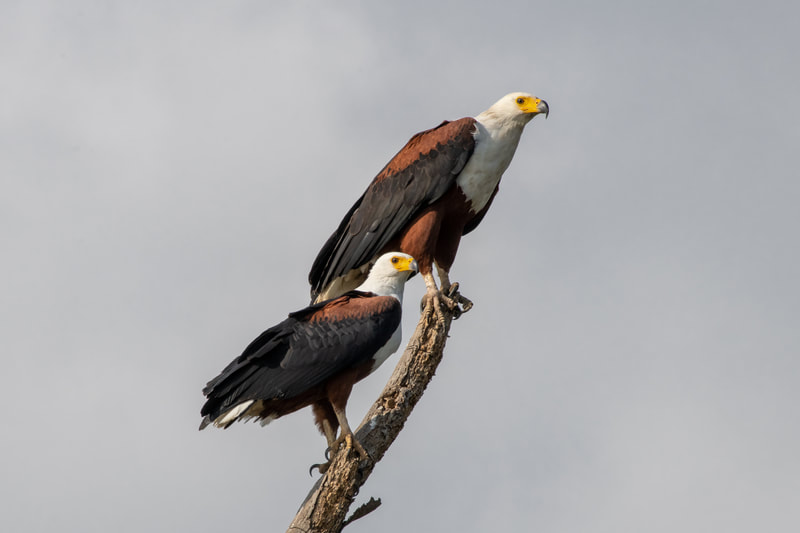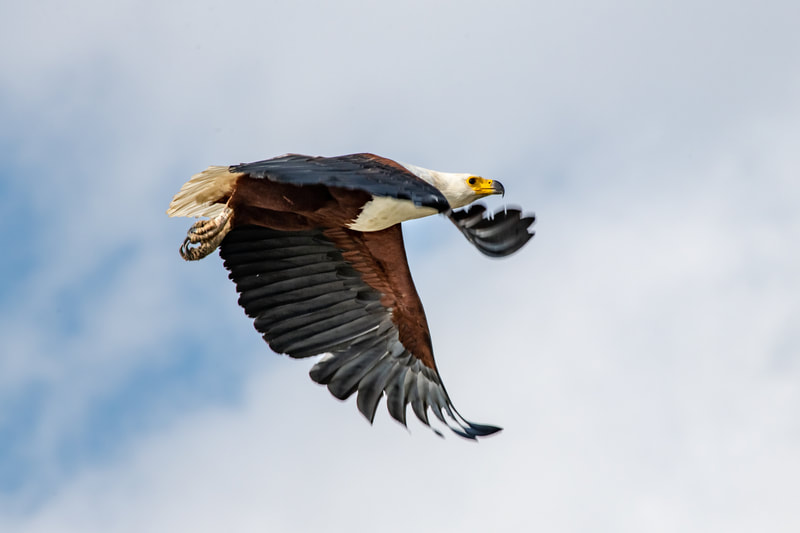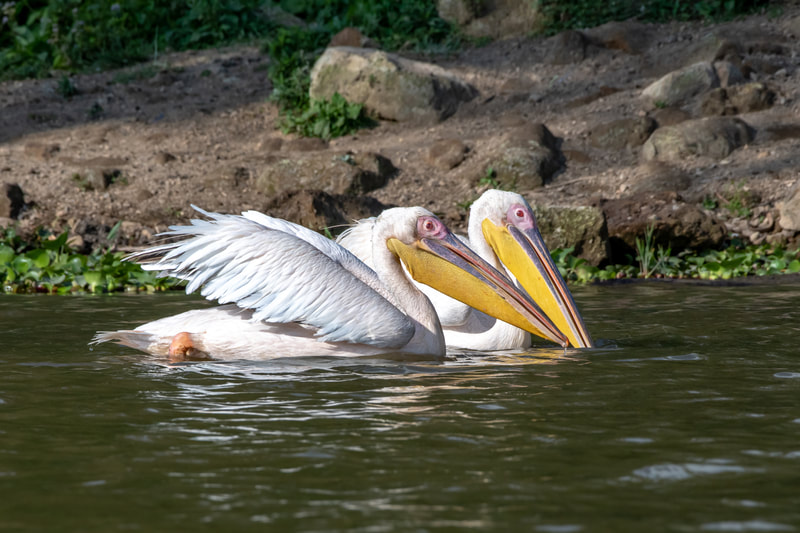Scroll down to photo gallery and/or scan through slide show above. The text below describes this spectacular trip in some detail.
In June of 2019, I embarked on one of my favorite trips ever, to Kenya with a focus on the northern half of the country. The "Northern Frontier", as much of that area is called, is mostly remote desert, far from the traditional Kenyan safari routes. But far from being an empty wasteland, Kenya's north is full of contrasts - stark, barren deserts, huge lakes, cool lush mountains, fascinating and colorful peoples, and some very unusual animals and birds. The scenery is spectacular, and there are a few very comfortable luxury camps sprinkled across this fascinating part of the world.
My guide was Benson (Ben) Mugambi of Ben's Ecological Safaris. Ben worked with me to customize a trip that combined all of my various interests: exploration of remote and little-visited areas, unusual birds and wildlife, photography, and culture. It was a relaxed pace, with two days in most places, allowing us to see some of the rarest and most unique birds and wildlife in Africa, and amazing villages of pastoral and fishing tribes. Every day had new adventures - one spectacular sight after another! Ben was tireless, and fully accommodated my needs, willing to stay as long as needed to get the photo I wanted or enjoy a longer look at anything of interest. He is one of the great birders in East Africa, able to find every rare species in the place it should be, but as the name of his company suggests, he is an ecologist, extremely knowledgeable about all creatures from insects to elephants, and eager to convey interesting information on all that one may find on one of his safaris. I cannot recommend Ben and his Ben's Ecological Safaris enough. If you want either a traditionally great East African safari, or something more unique such as the one described here, Ben's is a great way to do it (http://www.bensecologicalsafaris.com/). In particular, if you have done the traditional East African safari before, you might consider a trip like this around northern Kenya. If you have never been to Kenya or even East Africa, you probably need to visit the classic big game parks like Maasai Mara and Amboseli in Kenya, and Serengeti/Ngorongoro in Tanzania, but you could add something special and unique by spending a few extra days to visit places like Sarara Camp, or Ekorian's Mugie Camp, or even going all the way to Lake Turkana. Visiting those less-visited areas gives a whole different perspective and should make the trip even more memorable.
This trip started in Nairobi, as all Kenya safaris do. We spent most of the first day in Nairobi National Park, which is one of the most fascinating parks in the world, in that it has so much big game within sight of a major African city. I sensed that the trip would be special when the first mammal we saw was a Serval Cat, and one of the first birds an Africal Quailfinch (dozens at very close range!). From Nairobi we moved north to Mount Kenya (2 nights - cool to cold climate) and Samburu/Buffalo Springs (3 nights - hot and dry). Samburu is about as far north as most Kenya safaris go. It is one of the most game-rich and bird-rich parks in Africa, but the suite of wildlife is quite different from the savannah parks further south, with many species different from their southern relatives: Reticulated Giraffe, Grevy's Zebra, Beisa Oryx, Gunther's Dikdik, Gerenuk, Somali Ostrich, etc.
Moving north from Samburu, we entered Kenya's Northern Frontier, home to mostly pastoral peoples, traditionally nomadic or semi-nomadic, making a hard living in the arid lands. In this region, we stayed in three high-end camps (Desert Rose on the way north; Sabeche and Sarara on the way back down). One of the amazing things about those camps - in addition to the fact that you are very comfortable despite being in a remote wilderness - is that they are up in mountains that rise above the desert and are actually lush and cool. The link below and here called "Mountain Oases in the Desert" shows more. There is some big game in this region, but not too much compared to the more famous parks further South, but birding is great, as is the scenery and culture. Perhaps the most interesting aspect of this zone to me was the "singing wells". There is little available water, so the people and livestock depend largely on wells. Some of them are deep, so one has to climb down 10, 20 feet or more to reach water. Two or three men (at least in the three wells we visited, only men were doing this, no women) stand at different levels and pass buckets up to the surface, where the topmost man empties the water into a trough for livestock (cattle, goats, donkeys, and camels). As they do this, they "sing" (more like chanting), which, I was told, is partly to make the work go easier, but also as a signal to the livestock that water is being provided. In the wells we visited, masses of livestock would come running when the chanting started. And as an aside... we all have heard that camels can go days without drinking, and then when they get to water they drink and drink and drink. Well, when 3 or 4 camels came to a trough full of water, it sounded like a ships pump - 3 or 4 camels would suck a huge trough dry in seconds! Here are some videos of singing wells:
https://youtu.be/kvr1K9wa48U
https://youtu.be/M-G58cChZjk
https://youtu.be/N6kSFMBmpDU
We spent five+ days in the far north, on the eastern shore of Lake Turkana, then crossing the desert to Marsabit, then back down south. Lake Turkana is a true marvel - a huge blue green sea (called the Jade Sea by early British explorers) in the middle of a barren desert. The water is slightly saline, so no vegetation grows near its shores, except in those few places where there is a spring, forming palm-lined oases. We stayed in a town called Loiyangalani, at one of those oases on the east side of the lake. In the lake itself, there are lots of birds and crocs, and some huge Nile Perch, which made up most of our meals while there. Highlights in the area around Loiyangalani included spending some time in Rendille, Turkana, and El Molo villages, and driving up Mt. Kulal, a triangular massif east of the lake. Rising to 2,285 meters (7,497 ft), Kulal's summit is cool and lush, yet another mountain oasis rising over the desert. The highlight of that venture, in addition to the incredible scenery, was seeing several Kulal White-eyes at close range. They are pretty little yellow birds with white eye rings found only on Mt. Kulal. From Turkana, we crossed the Chalbi Desert to Marsabit, and the drive was without doubt one of the trip highlights. Over several stages, there was nothing but flat, burning sand, and mirages! Then, purple and orange and pink mountains would break the flatness, along with some brushy areas of semidesert scrub, and even a few lush oases with palm trees and standing water. And through it all, except in the very driest areas, people (mostly Gabra) found ways to survive with their camels in this hostile land. And then we rose toward the series of craters and mountains around Mount Marsabit and Marsabit town. We were once again in "civilization", and in another cool (almost cold) mountain oasis.
After a day of exploring Marsabit National Park and its picturesque craters filled with wildlife and birds, we began the journey south, stopping at Sabache and Sarara Camps mentioned previously. The scenery around both is spectacular and unique; especially Sarara. We then crossed over to a fabulous place called Ekorian's Mugie Camp. Ekorian's sits atop the Laikipia Plateau, a cool and lush grassland with extensive wetlands, full of big game and birds, offering great photographic opportunities. From Ekorian's we spent the final five days working our way back to Nairobi via some of Kenya's Rift Valley lakes: Baringo, Bogoria, Nakuru, and finally Naivasha, with most of that time at Baringo and Nakuru. All four lakes are great for birding, with Bogoria and Nakuru especially famous for their masses of flamingos. Lake Nakuru deserves special mention because, despite being a tiny park, most of which is the lake itself, it is a fantastic place to see and photograph wildlife, with many common species abundant in large numbers and easy to approach. The park has introduced Black and White Rhinos (the latter is easy to see; we did not see the former) and Rothschild's Giraffes. The only slight drawback to Lake Nakuru was the crowds - we had been spoiled by 2 weeks in the beautiful north seeing hardly any tourists at all! - Lake Nakuru Lodge was very full, as it should be given what the park has to offer, but it made us smile and appreciate all the more the gift we had had of traveling all around the north with so many destination gems, almost all to ourselves.
A fun and unexpected ending to the trip occurred as we left Nakuru on our last day. I lived in Kenya for one year in 1976-77, and spent much of that time in Nakuru, on a student program where we helped to build two schools. I thought I remembered that one of those schools was called Kagoto Primary School, and even approximately where it was. With a little help from "Dr. Google", we were able to locate it and pay an unannounced visit. It was indeed the place, and seemed to be a thriving school! I was given a fantastic, warm greeting when I explained that I had actually helped (just a bit) to build the school way back in 1976! The headmaster from that time had only recently retired, and I was able to talk with him by phone. He actually remembered me and the program (called Interalp) that helped build the school. He even later emailed me an image of a Christmas card I had once sent him, still had in his possession! We donated writing pads, pens and pencils, and a soccer ball, and had a nice little celebration. A wonderful ending to a wonderful trip!
The gallery below shows highlights from the trip. For more photos and details on different sections of the trip, see also these links:
- Nairobi NationalPark and Mt. Kenya (the trip begins)
- Samburu Game Reserve - Gateway to the Northern Frontier
- Lake Turkana area, including Mt. Kulal
- Marsabit area
- Mountain Oases above the Desert
- Rift Valley Lakes (the last leg on the way back to Nairobi)
In June of 2019, I embarked on one of my favorite trips ever, to Kenya with a focus on the northern half of the country. The "Northern Frontier", as much of that area is called, is mostly remote desert, far from the traditional Kenyan safari routes. But far from being an empty wasteland, Kenya's north is full of contrasts - stark, barren deserts, huge lakes, cool lush mountains, fascinating and colorful peoples, and some very unusual animals and birds. The scenery is spectacular, and there are a few very comfortable luxury camps sprinkled across this fascinating part of the world.
My guide was Benson (Ben) Mugambi of Ben's Ecological Safaris. Ben worked with me to customize a trip that combined all of my various interests: exploration of remote and little-visited areas, unusual birds and wildlife, photography, and culture. It was a relaxed pace, with two days in most places, allowing us to see some of the rarest and most unique birds and wildlife in Africa, and amazing villages of pastoral and fishing tribes. Every day had new adventures - one spectacular sight after another! Ben was tireless, and fully accommodated my needs, willing to stay as long as needed to get the photo I wanted or enjoy a longer look at anything of interest. He is one of the great birders in East Africa, able to find every rare species in the place it should be, but as the name of his company suggests, he is an ecologist, extremely knowledgeable about all creatures from insects to elephants, and eager to convey interesting information on all that one may find on one of his safaris. I cannot recommend Ben and his Ben's Ecological Safaris enough. If you want either a traditionally great East African safari, or something more unique such as the one described here, Ben's is a great way to do it (http://www.bensecologicalsafaris.com/). In particular, if you have done the traditional East African safari before, you might consider a trip like this around northern Kenya. If you have never been to Kenya or even East Africa, you probably need to visit the classic big game parks like Maasai Mara and Amboseli in Kenya, and Serengeti/Ngorongoro in Tanzania, but you could add something special and unique by spending a few extra days to visit places like Sarara Camp, or Ekorian's Mugie Camp, or even going all the way to Lake Turkana. Visiting those less-visited areas gives a whole different perspective and should make the trip even more memorable.
This trip started in Nairobi, as all Kenya safaris do. We spent most of the first day in Nairobi National Park, which is one of the most fascinating parks in the world, in that it has so much big game within sight of a major African city. I sensed that the trip would be special when the first mammal we saw was a Serval Cat, and one of the first birds an Africal Quailfinch (dozens at very close range!). From Nairobi we moved north to Mount Kenya (2 nights - cool to cold climate) and Samburu/Buffalo Springs (3 nights - hot and dry). Samburu is about as far north as most Kenya safaris go. It is one of the most game-rich and bird-rich parks in Africa, but the suite of wildlife is quite different from the savannah parks further south, with many species different from their southern relatives: Reticulated Giraffe, Grevy's Zebra, Beisa Oryx, Gunther's Dikdik, Gerenuk, Somali Ostrich, etc.
Moving north from Samburu, we entered Kenya's Northern Frontier, home to mostly pastoral peoples, traditionally nomadic or semi-nomadic, making a hard living in the arid lands. In this region, we stayed in three high-end camps (Desert Rose on the way north; Sabeche and Sarara on the way back down). One of the amazing things about those camps - in addition to the fact that you are very comfortable despite being in a remote wilderness - is that they are up in mountains that rise above the desert and are actually lush and cool. The link below and here called "Mountain Oases in the Desert" shows more. There is some big game in this region, but not too much compared to the more famous parks further South, but birding is great, as is the scenery and culture. Perhaps the most interesting aspect of this zone to me was the "singing wells". There is little available water, so the people and livestock depend largely on wells. Some of them are deep, so one has to climb down 10, 20 feet or more to reach water. Two or three men (at least in the three wells we visited, only men were doing this, no women) stand at different levels and pass buckets up to the surface, where the topmost man empties the water into a trough for livestock (cattle, goats, donkeys, and camels). As they do this, they "sing" (more like chanting), which, I was told, is partly to make the work go easier, but also as a signal to the livestock that water is being provided. In the wells we visited, masses of livestock would come running when the chanting started. And as an aside... we all have heard that camels can go days without drinking, and then when they get to water they drink and drink and drink. Well, when 3 or 4 camels came to a trough full of water, it sounded like a ships pump - 3 or 4 camels would suck a huge trough dry in seconds! Here are some videos of singing wells:
https://youtu.be/kvr1K9wa48U
https://youtu.be/M-G58cChZjk
https://youtu.be/N6kSFMBmpDU
We spent five+ days in the far north, on the eastern shore of Lake Turkana, then crossing the desert to Marsabit, then back down south. Lake Turkana is a true marvel - a huge blue green sea (called the Jade Sea by early British explorers) in the middle of a barren desert. The water is slightly saline, so no vegetation grows near its shores, except in those few places where there is a spring, forming palm-lined oases. We stayed in a town called Loiyangalani, at one of those oases on the east side of the lake. In the lake itself, there are lots of birds and crocs, and some huge Nile Perch, which made up most of our meals while there. Highlights in the area around Loiyangalani included spending some time in Rendille, Turkana, and El Molo villages, and driving up Mt. Kulal, a triangular massif east of the lake. Rising to 2,285 meters (7,497 ft), Kulal's summit is cool and lush, yet another mountain oasis rising over the desert. The highlight of that venture, in addition to the incredible scenery, was seeing several Kulal White-eyes at close range. They are pretty little yellow birds with white eye rings found only on Mt. Kulal. From Turkana, we crossed the Chalbi Desert to Marsabit, and the drive was without doubt one of the trip highlights. Over several stages, there was nothing but flat, burning sand, and mirages! Then, purple and orange and pink mountains would break the flatness, along with some brushy areas of semidesert scrub, and even a few lush oases with palm trees and standing water. And through it all, except in the very driest areas, people (mostly Gabra) found ways to survive with their camels in this hostile land. And then we rose toward the series of craters and mountains around Mount Marsabit and Marsabit town. We were once again in "civilization", and in another cool (almost cold) mountain oasis.
After a day of exploring Marsabit National Park and its picturesque craters filled with wildlife and birds, we began the journey south, stopping at Sabache and Sarara Camps mentioned previously. The scenery around both is spectacular and unique; especially Sarara. We then crossed over to a fabulous place called Ekorian's Mugie Camp. Ekorian's sits atop the Laikipia Plateau, a cool and lush grassland with extensive wetlands, full of big game and birds, offering great photographic opportunities. From Ekorian's we spent the final five days working our way back to Nairobi via some of Kenya's Rift Valley lakes: Baringo, Bogoria, Nakuru, and finally Naivasha, with most of that time at Baringo and Nakuru. All four lakes are great for birding, with Bogoria and Nakuru especially famous for their masses of flamingos. Lake Nakuru deserves special mention because, despite being a tiny park, most of which is the lake itself, it is a fantastic place to see and photograph wildlife, with many common species abundant in large numbers and easy to approach. The park has introduced Black and White Rhinos (the latter is easy to see; we did not see the former) and Rothschild's Giraffes. The only slight drawback to Lake Nakuru was the crowds - we had been spoiled by 2 weeks in the beautiful north seeing hardly any tourists at all! - Lake Nakuru Lodge was very full, as it should be given what the park has to offer, but it made us smile and appreciate all the more the gift we had had of traveling all around the north with so many destination gems, almost all to ourselves.
A fun and unexpected ending to the trip occurred as we left Nakuru on our last day. I lived in Kenya for one year in 1976-77, and spent much of that time in Nakuru, on a student program where we helped to build two schools. I thought I remembered that one of those schools was called Kagoto Primary School, and even approximately where it was. With a little help from "Dr. Google", we were able to locate it and pay an unannounced visit. It was indeed the place, and seemed to be a thriving school! I was given a fantastic, warm greeting when I explained that I had actually helped (just a bit) to build the school way back in 1976! The headmaster from that time had only recently retired, and I was able to talk with him by phone. He actually remembered me and the program (called Interalp) that helped build the school. He even later emailed me an image of a Christmas card I had once sent him, still had in his possession! We donated writing pads, pens and pencils, and a soccer ball, and had a nice little celebration. A wonderful ending to a wonderful trip!
The gallery below shows highlights from the trip. For more photos and details on different sections of the trip, see also these links:
- Nairobi NationalPark and Mt. Kenya (the trip begins)
- Samburu Game Reserve - Gateway to the Northern Frontier
- Lake Turkana area, including Mt. Kulal
- Marsabit area
- Mountain Oases above the Desert
- Rift Valley Lakes (the last leg on the way back to Nairobi)

